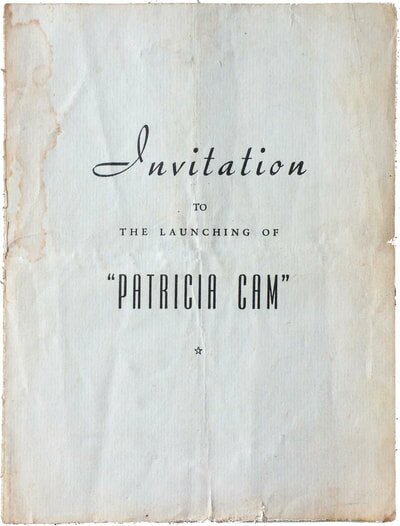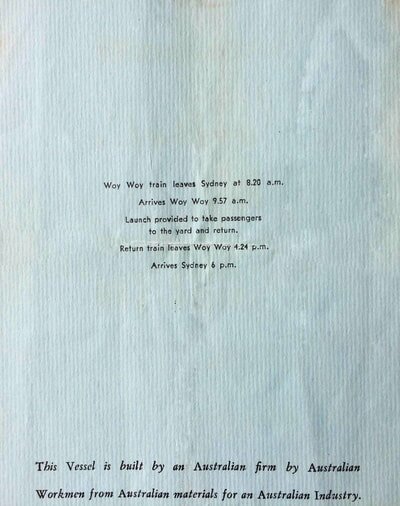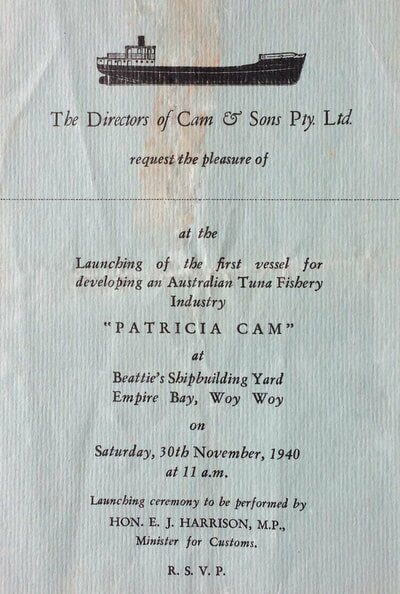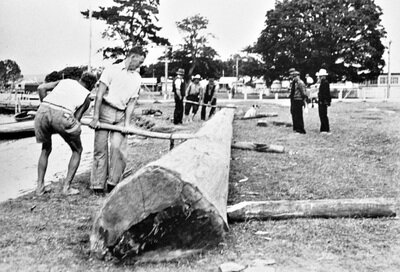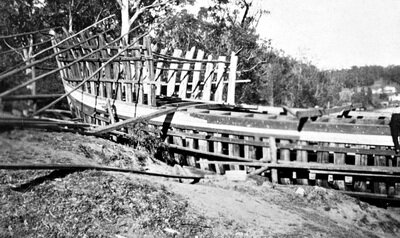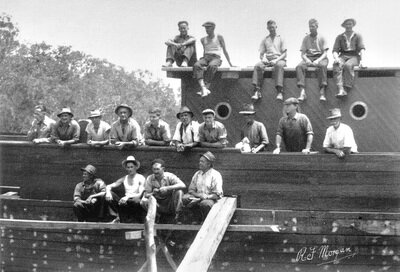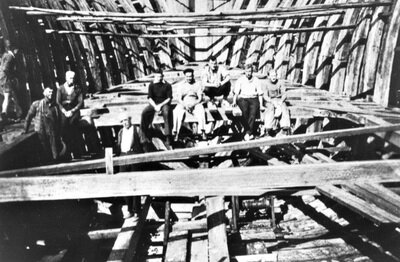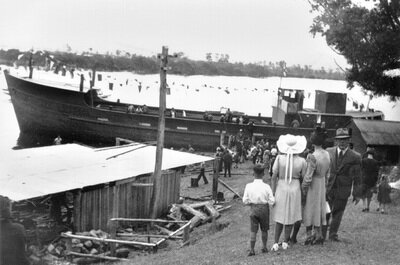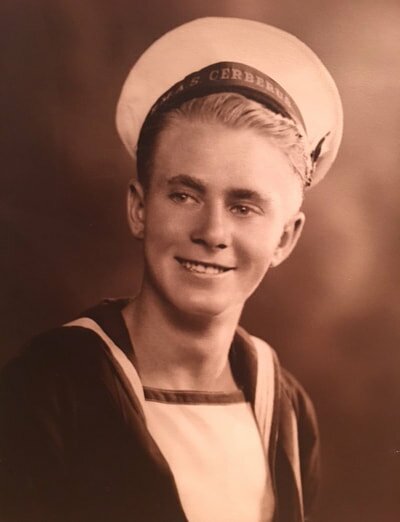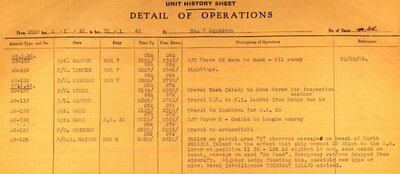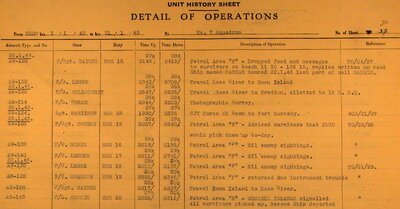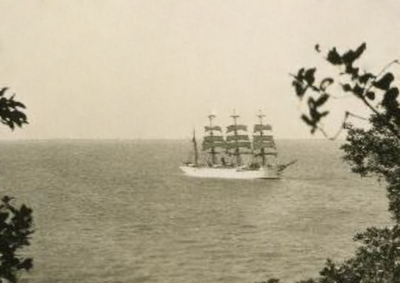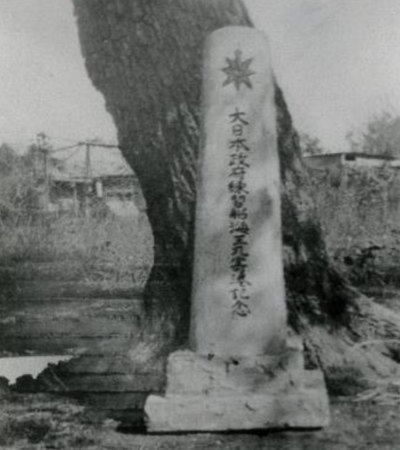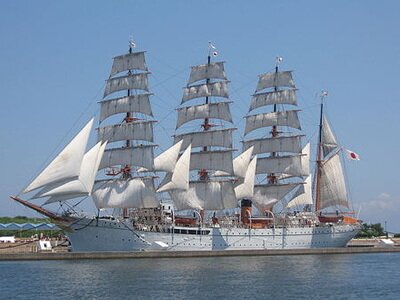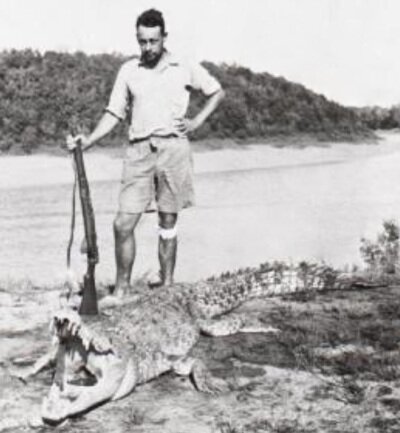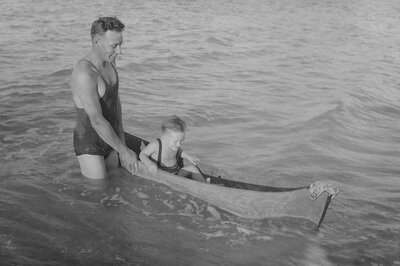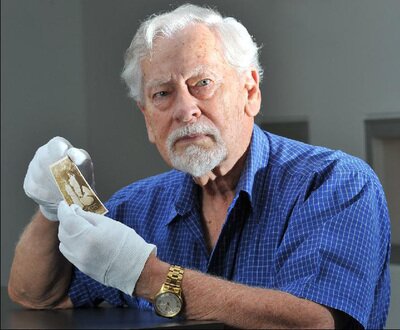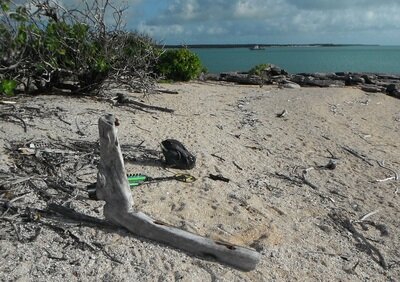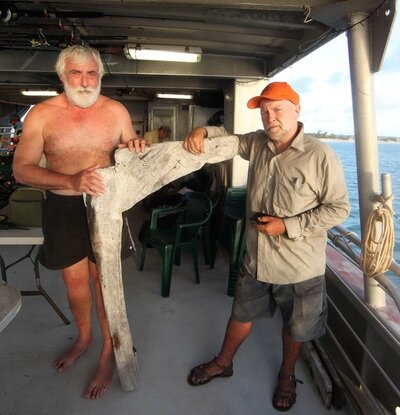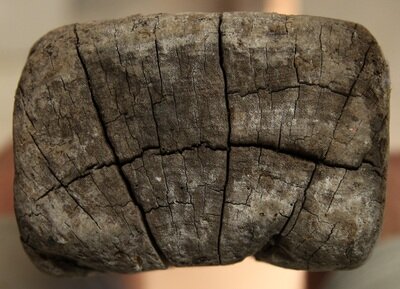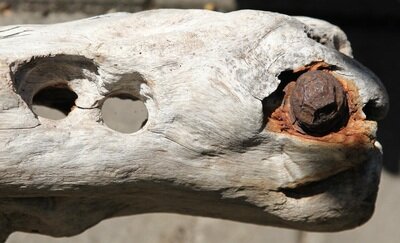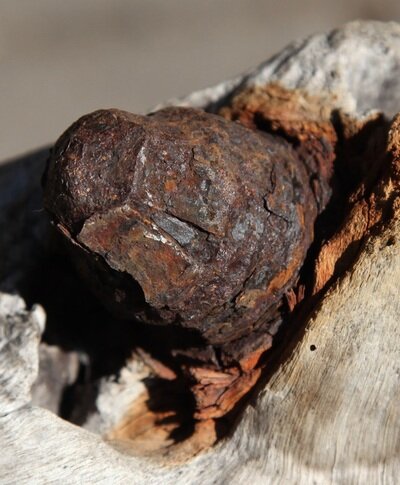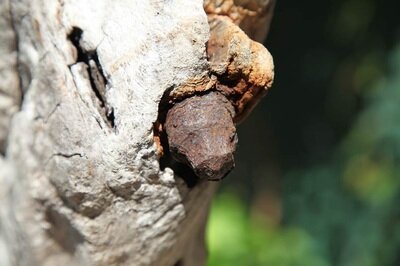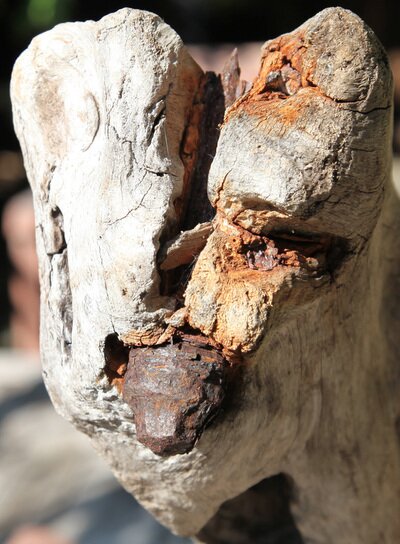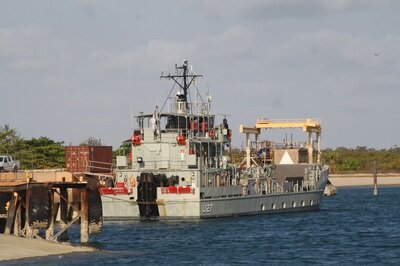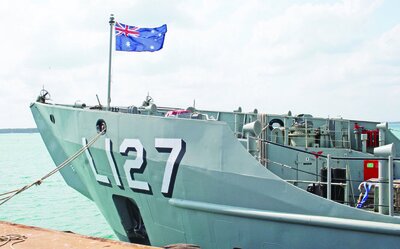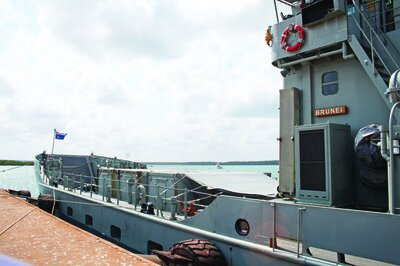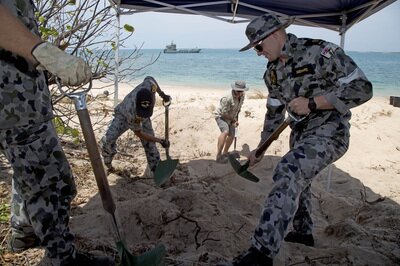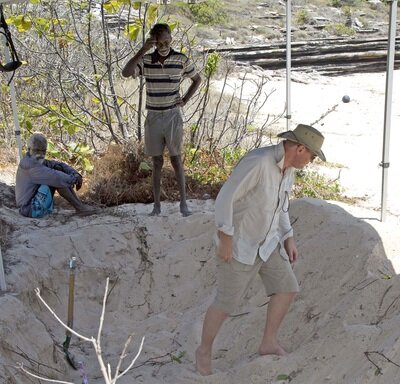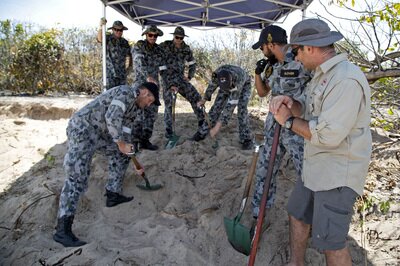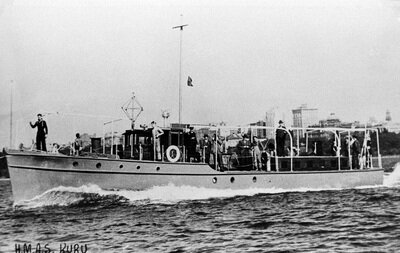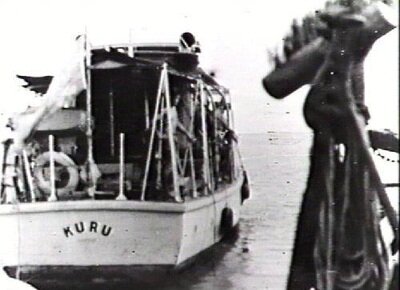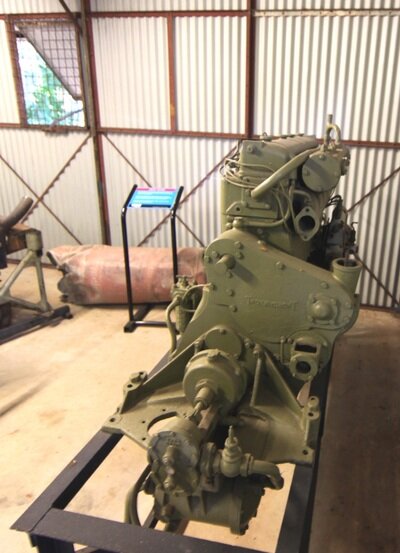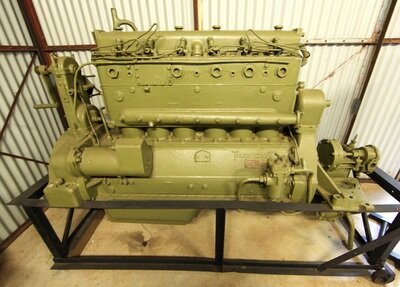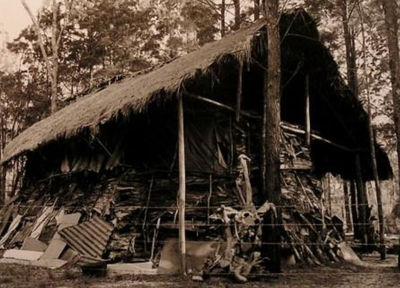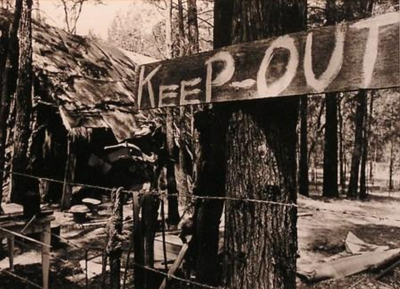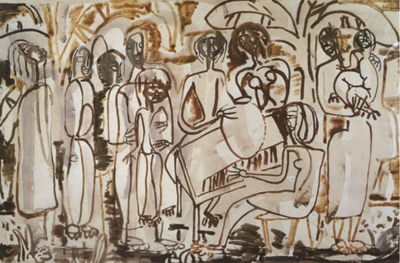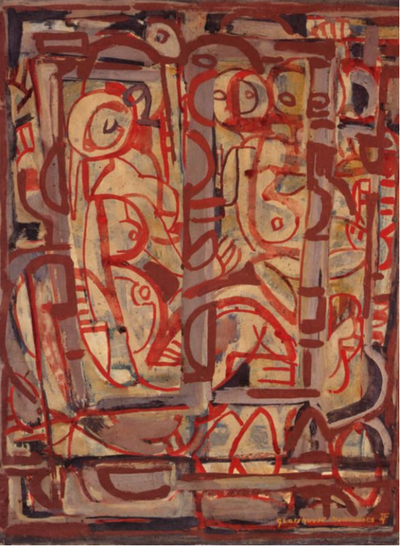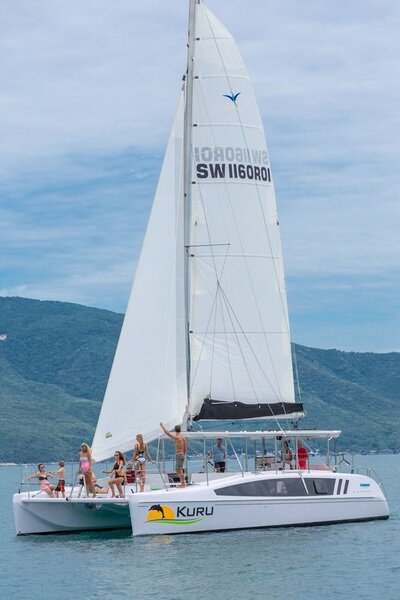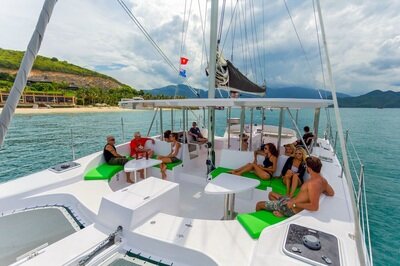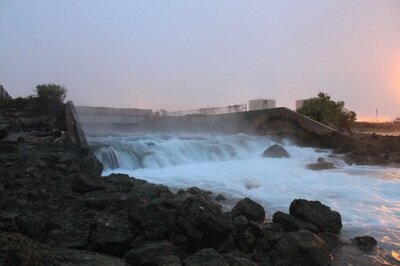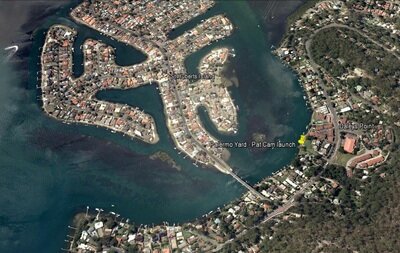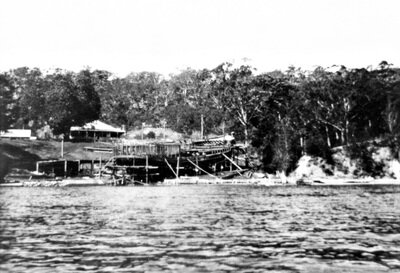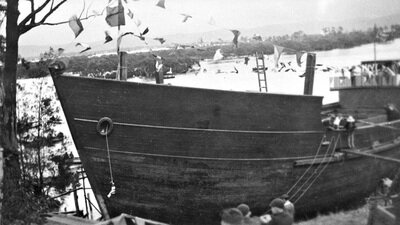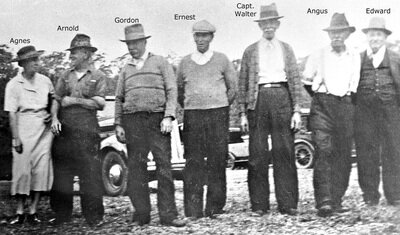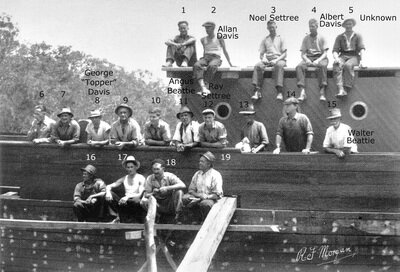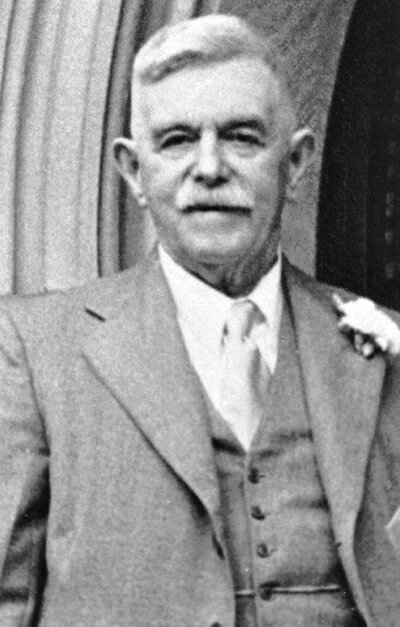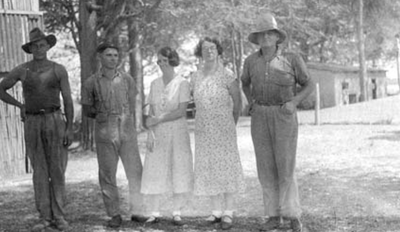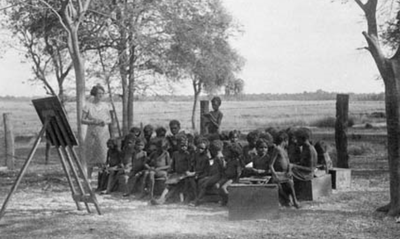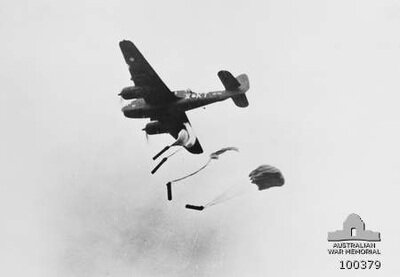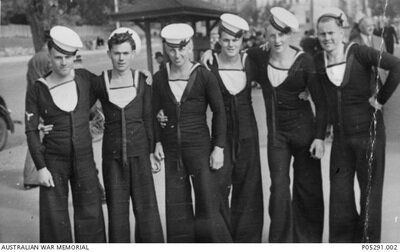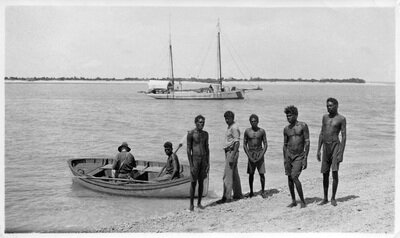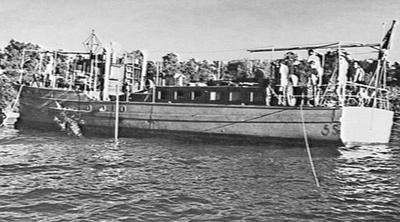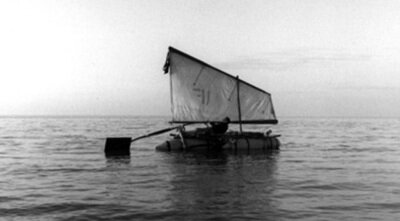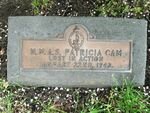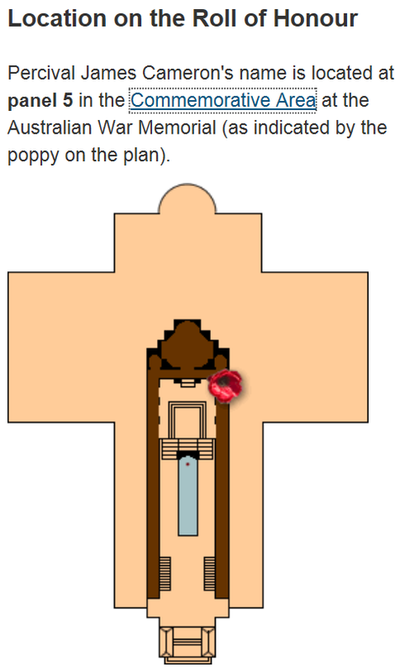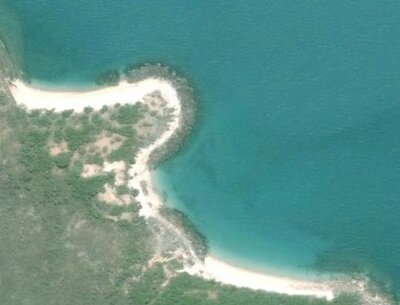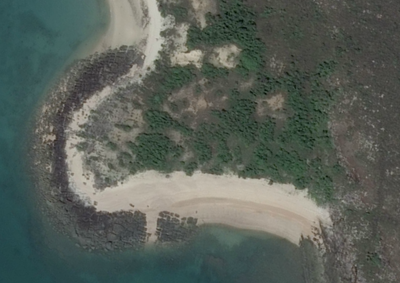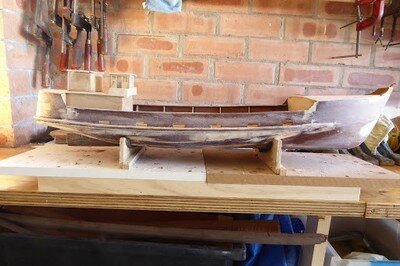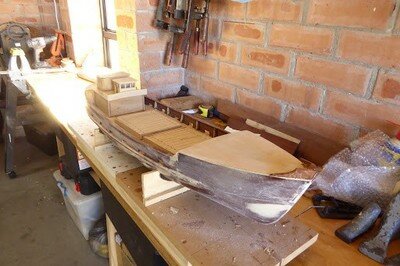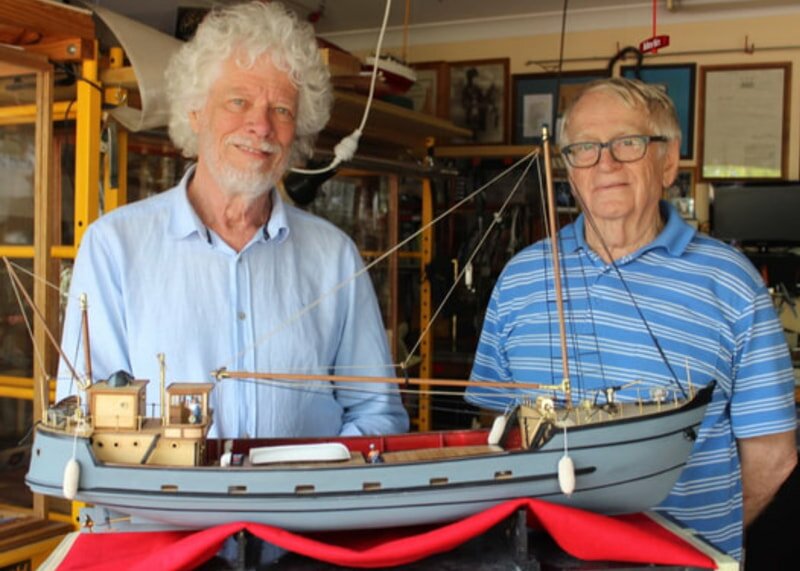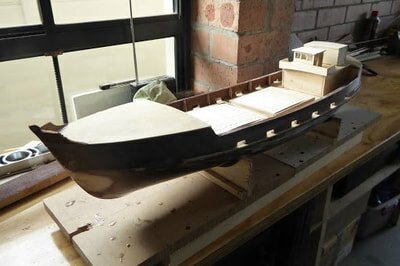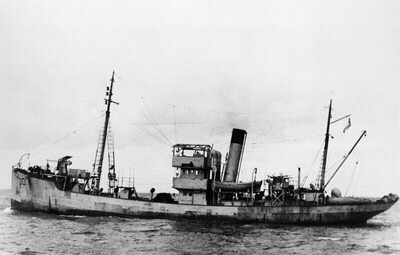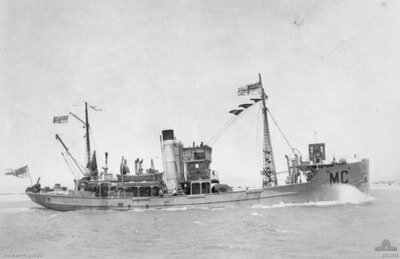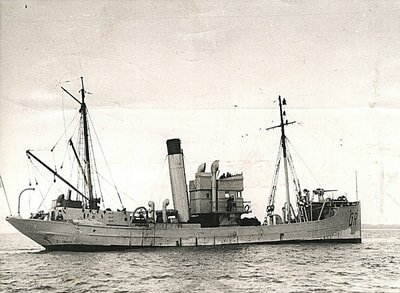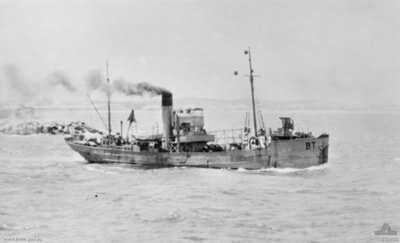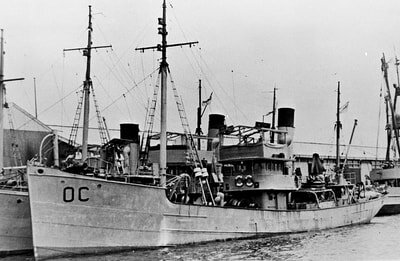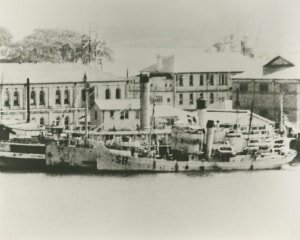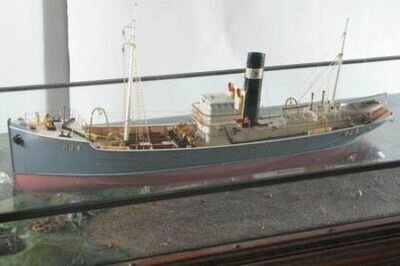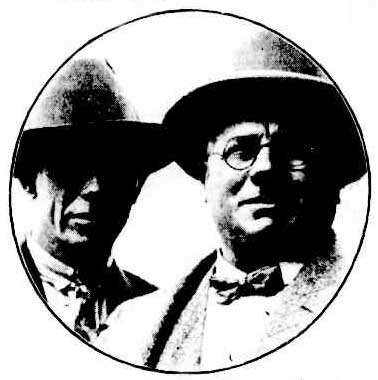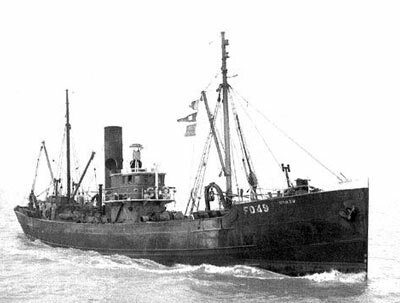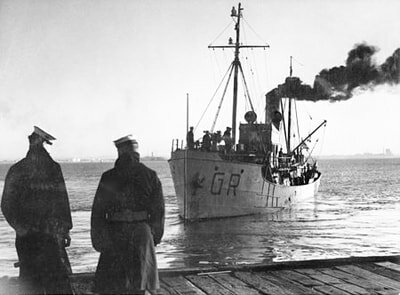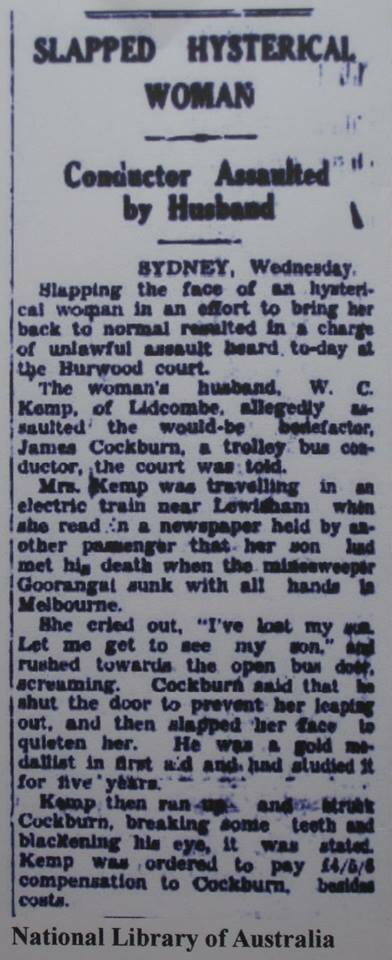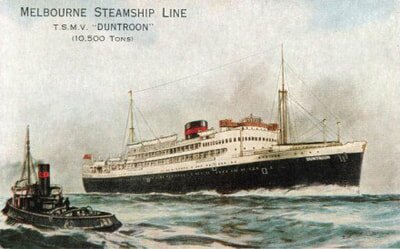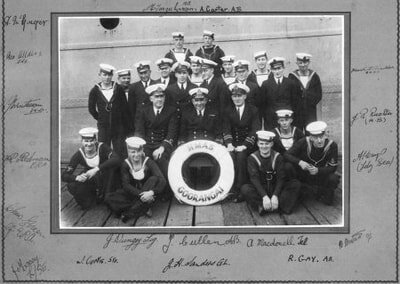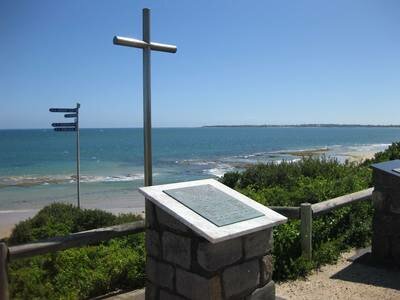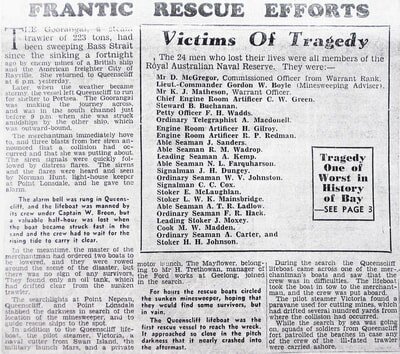HMAS Patricia Cam
This project of research, engagement & commemoration has been made possible by the generous support of Minelab Australia - Australian Geographic - The East Arnhem Regional Council - The Gumatj & Rirratjingu Associations - The Northern Territory Government through
The NT History Grants and The Territory Remembers Programs
The NT History Grants and The Territory Remembers Programs
75th ANNIVERSARY PROGRAM
|
|
||||||
The Pat Cam Story in Brief
 Pat Cam Memorial, Yirrkala - Mitchell Woolnough image - ABC TV
Pat Cam Memorial, Yirrkala - Mitchell Woolnough image - ABC TV
75 years ago, during World War II, Japanese planes had bombed Darwin & attacked shipping. The air force, radar, coastwatch & mission stations along the coast between Darwin and Groote Eylandt were supplied by HMAS Patricia Cam.
The missionary at Yirrkala, Harold Thornell, was also the Coastwatcher - expecting new code books he sent Djimanbuy & Djinipula Yunupingu; Narritjin Maymuru & Milirrma Marika to Elcho Island to check the mail - not knowing that the head of the Coastwatchers, missionary Rev. Len Kentish, was bringing them on the Patricia Cam. They met at Galiwin’ku & the 4 Yolngu with their canoe, were taken aboard for the trip up to Jensen Bay then home to Yirrkala.
An hour after midday on Friday 22nd January 1943, the ship was bombed by a Japanese seaplane. Aboard were 19 crew, 5 Yolngu & one missionary. The bomb fell through the open hatch and blew her bottom away - the furious sea rushed in with such force that men who fell into the hold were flushed out again without a scratch.
Crewman Neil Penglase & Djinipula Yunupingu died at once, with Edward Nobes & Djimanbuy Yunupingu killed in the water by a second bomb – Len Kentish was captured & flown to Dobo in the Aru Islands – William Moffitt & Andrew Johnston floated away in the night & were not seen again. The others gathered around a life raft which they took turns to paddle towards land. Early next morning 15 crew & 3 Yolngu reached Gurraka Island off Guluwuru Island. The men had barely dragged themselves from the sea before Paddy Babawun Wanambi of Milingimbi, had a fire going & found fresh water.
Percy Cameron died that morning & Milirrma Marika died in the afternoon. They were buried side by side, their graves covered with rocks. A signal fire was lit & early next afternoon Paddy & Narritjin saw smoke from the south & headed off to get help. They met Dika below the Gulgari Rip – he took them down to Elcho Island whilst his son Militjbi & family went north reaching the survivors late the next morning announcing “We have come to look after you”.
The captain, Alexander Meldrum, set off with some of the Yolngu to cross Cumberland Strait and begin the 34 hour barefoot walk, more than 25 miles up Marchinbar Island, to the coastwatcher station on Jensen Bay. Arriving late the next evening, Wet season storms prevented radio contact with Darwin.
Coastwatcher Jack Jensen knew an RAAF Beaufort did a daily flight looking for the Japanese invasion fleet & it passed over the top of the island. Early next morning he was dancing on the beach, waving his arms like a madman to attract the pilot to his message in the sand & the arrow pointing south. He finally got a radio message out at 0930 that was heard by Thornell and Darwin. By mid-morning pilot Len Gairns was over the survivors’ beach, he dropped a message and his rations before heading for his base at Horn Island.
Jack Jensen had sent 4 Yolngu south to help the survivors & they arrived later that afternoon. An hour before midnight HMAS Kuru left Darwin for the Wessels which she reached on last light of the following day - one week after the sinking of HAMS Patricia Cam. It was dark by the time they were all aboard, leaving Percy and Milirrma to the guard the silence. Paddy guided Kuru through the night to Jensen Bay to collect Meldrum & head for Darwin which they reached at 10am on Monday 1st February 1943.
It would be 3 years before Mrs Violet Kentish learned that her husband had been beaten & beheaded by his captors and another 2 years before his murderer would be hanged in Hong Kong Jail as a war criminal.
70 years later the PastMasters found a piece of a wooden ship that led to the Patricia Cam story, the location of the survivors’ island & contact with Percy Cameron’s daughter Jan Braund. It would be a further 4 years before all the Yolngu were identified & the full story told to the families gathered to dedicate the memorial at Yirrkala on the 24th April 2017. Over 70 descendants of servicemen involved have been contacted & preparations are underway for events to commemorate the 75th anniversary on 22nd January 2018 at Brisbane Water & a Last Post ceremony at the Australian War Memorial in Canberra.
The missionary at Yirrkala, Harold Thornell, was also the Coastwatcher - expecting new code books he sent Djimanbuy & Djinipula Yunupingu; Narritjin Maymuru & Milirrma Marika to Elcho Island to check the mail - not knowing that the head of the Coastwatchers, missionary Rev. Len Kentish, was bringing them on the Patricia Cam. They met at Galiwin’ku & the 4 Yolngu with their canoe, were taken aboard for the trip up to Jensen Bay then home to Yirrkala.
An hour after midday on Friday 22nd January 1943, the ship was bombed by a Japanese seaplane. Aboard were 19 crew, 5 Yolngu & one missionary. The bomb fell through the open hatch and blew her bottom away - the furious sea rushed in with such force that men who fell into the hold were flushed out again without a scratch.
Crewman Neil Penglase & Djinipula Yunupingu died at once, with Edward Nobes & Djimanbuy Yunupingu killed in the water by a second bomb – Len Kentish was captured & flown to Dobo in the Aru Islands – William Moffitt & Andrew Johnston floated away in the night & were not seen again. The others gathered around a life raft which they took turns to paddle towards land. Early next morning 15 crew & 3 Yolngu reached Gurraka Island off Guluwuru Island. The men had barely dragged themselves from the sea before Paddy Babawun Wanambi of Milingimbi, had a fire going & found fresh water.
Percy Cameron died that morning & Milirrma Marika died in the afternoon. They were buried side by side, their graves covered with rocks. A signal fire was lit & early next afternoon Paddy & Narritjin saw smoke from the south & headed off to get help. They met Dika below the Gulgari Rip – he took them down to Elcho Island whilst his son Militjbi & family went north reaching the survivors late the next morning announcing “We have come to look after you”.
The captain, Alexander Meldrum, set off with some of the Yolngu to cross Cumberland Strait and begin the 34 hour barefoot walk, more than 25 miles up Marchinbar Island, to the coastwatcher station on Jensen Bay. Arriving late the next evening, Wet season storms prevented radio contact with Darwin.
Coastwatcher Jack Jensen knew an RAAF Beaufort did a daily flight looking for the Japanese invasion fleet & it passed over the top of the island. Early next morning he was dancing on the beach, waving his arms like a madman to attract the pilot to his message in the sand & the arrow pointing south. He finally got a radio message out at 0930 that was heard by Thornell and Darwin. By mid-morning pilot Len Gairns was over the survivors’ beach, he dropped a message and his rations before heading for his base at Horn Island.
Jack Jensen had sent 4 Yolngu south to help the survivors & they arrived later that afternoon. An hour before midnight HMAS Kuru left Darwin for the Wessels which she reached on last light of the following day - one week after the sinking of HAMS Patricia Cam. It was dark by the time they were all aboard, leaving Percy and Milirrma to the guard the silence. Paddy guided Kuru through the night to Jensen Bay to collect Meldrum & head for Darwin which they reached at 10am on Monday 1st February 1943.
It would be 3 years before Mrs Violet Kentish learned that her husband had been beaten & beheaded by his captors and another 2 years before his murderer would be hanged in Hong Kong Jail as a war criminal.
70 years later the PastMasters found a piece of a wooden ship that led to the Patricia Cam story, the location of the survivors’ island & contact with Percy Cameron’s daughter Jan Braund. It would be a further 4 years before all the Yolngu were identified & the full story told to the families gathered to dedicate the memorial at Yirrkala on the 24th April 2017. Over 70 descendants of servicemen involved have been contacted & preparations are underway for events to commemorate the 75th anniversary on 22nd January 2018 at Brisbane Water & a Last Post ceremony at the Australian War Memorial in Canberra.
- UNRECOVERED -
The HMAS Patricia Cam Story
 Patricia Cam at Cockle Creek in Gordon Beattie's Palermo Yard - the stern clearly is not that of a trawler. Lifeboat at right. RJ Morgan image courtesy Carmel Mimica - daughter of Allan Davis who was a carpenter on the Pat Cam construction.
Patricia Cam at Cockle Creek in Gordon Beattie's Palermo Yard - the stern clearly is not that of a trawler. Lifeboat at right. RJ Morgan image courtesy Carmel Mimica - daughter of Allan Davis who was a carpenter on the Pat Cam construction.
The story of HMAS Patricia Cam begins on Brisbane Water north of Sydney at the outbreak of WWII - scarcity of metal saw Government re-invigorate the building of wooden ships. Power was connected to the Palermo Yard of Gordon Beattie at Empire Bay - an electric drill and a power saw were innovations.
The 120ft 9ins long - 301 ton Patricia Cam, was named for the grand-daughter of the owner of a fleet of fishing vessels & coal mines. The Pat Cam was part of a significant 1,000,000 pound Government scheme to promote Australian hardwood shipbuilding which had begun at the end of the Great War. Her specifications, to naval architect AC "Ali" Barber, were that, with a 6'6" draft, she be able to carry 200 tons of coal from the owner's mine on Lake Macquarie - out through the channel at Swansea -for delivery to the owner's depot at Pyrmont - for unloading by mechanical grabs for which a single, capacious hold was required.
She also had provision for refrigeration - so some fishery 'mother-ship' role may have been envisaged. Unusually, she was built entirely of hardwood, with 'tween decks & an especially thick, double skin bottom for rigidity & protection against the shallow river mouth transits.
 Patricia Cam with beer bottle - image courtesy Gwen Dundon.
Patricia Cam with beer bottle - image courtesy Gwen Dundon.
Her launching on Saturday 30 November 1940 was a fiasco as can be seen from the accompanying images courtesy of Gwen Dundon, author of 'The Shipbuilders of Brisbane Water NSW' and the Gosford Historical Society.
Miss Patricia Cam was the granddaughter of the owner. Born in 1926 she became Mrs Pinnock and was Top Agency Development Manager of the NSW Building Society. Mother of Adrian Bryce, Simon John & Adam Rocco she passed away in 1999 and is interred at South Head Cemetery.
The press inferred that an over-refreshed yard worker mistook a pause in the Minister's speech & let the Pat Cam go down the ways beyond the desperate reach of a tearful Miss Patricia Cam, who was poised to do the honours. In fact the Honourable Member went to Rock Davis shipyard by mistake and then spoke so long he tired the tide which retreated at such a pace that the order was given "to send her off" before she got stranded.
Two small boys accounted for the bottle & the subsequent use of beer instead of wine was a sin against the sea Gods that would be fatally compounded two years & two months later by having on board a man of the cloth.
Miss Patricia Cam was the granddaughter of the owner. Born in 1926 she became Mrs Pinnock and was Top Agency Development Manager of the NSW Building Society. Mother of Adrian Bryce, Simon John & Adam Rocco she passed away in 1999 and is interred at South Head Cemetery.
The press inferred that an over-refreshed yard worker mistook a pause in the Minister's speech & let the Pat Cam go down the ways beyond the desperate reach of a tearful Miss Patricia Cam, who was poised to do the honours. In fact the Honourable Member went to Rock Davis shipyard by mistake and then spoke so long he tired the tide which retreated at such a pace that the order was given "to send her off" before she got stranded.
Two small boys accounted for the bottle & the subsequent use of beer instead of wine was a sin against the sea Gods that would be fatally compounded two years & two months later by having on board a man of the cloth.
From her launch, in late November 1940, to her commissioning in March 1942, the Pat Cam operated as a collier voyaging up the coast to Lake Macquarie north of Sydney where Cam & Son's leased Aberfield colliery near Swansea then returning to his finger wharf at No.1 Bank Street Pyrmont (see Cam's Trawlers by Graeme Andrews). She had a capacious hold in which her builders would play cricket during the lunch hour. She was just one vast hold with a large engine up forward for the anchor and top lift derrick. The lifeboat is on the stern with its own derrick and there was a raft atop the deckhouse aft.
This is the only image of the Pat Cam ready for sea, she is incapable of operating as a trawler & is flying the White Ensign. The image was taken at Sydney Docks and she may be loading coal for the voyage to Darwin. Confusion has arisen because there is a vessel moored between her and the wharf which gives her the forest of masts and the forward facing funnel. This confusion persisted right through to the oil painting by Dacre Smythe.

"Chaplain Gilmore's Seagoing Tent (HMAS Patricia Cam at Darwin 1942) The 300 ton fishing vessel "PATRICIA CAM" was built in 1940 and requisitioned by the Australian Navy in February 1942 for service as a stores carrier out of Darwin. She was sunk by a Japanese float-plane off Darwin on 22nd January 1943. In the painting she is in Darwin Harbour with a tent on deck, pitched there by the Captain E.E.O. Gunn as accommodation for RAAF Chaplain Gilmore who was serving on board at the time. By Dacre Smyth 1990.' She is shown with metal plates & the tent is the waterproof canvas hatch cover. Courtesy Ben Gilmore
The Don Isidro
Once commissioned, the Pat Cam was sent north to Port Darwin where she was a familiar sight around the harbour doing general duties including support of the anti-submarine boom. She was involved in the forlorn efforts to re-float the Filipino blockade runner Don Isidro which was bombed by the Japanese & beached on Bathurst Island on 19th February 1942 preparatory to the first raid on Darwin. She was carrying supplies & munitions under US Army Transport (USAT) charter. Badly damaged, she was driven ashore and wrecked with the loss of one US officer and 13 Filipino crew. There is a survivor camp & graves. Her bell is at Pirlangimpi.

The first action on the 19th Feb. 1942 was the shooting down of a US Navy Catalina that had just left Darwin. She had descended to check the registration of the Don Isidro and failed to notice the approaching Japanese top cover flight from which two had Zeros had detached to brass up the Catalina and the Don Isidro.
The Pilot Tom Moorer managed to land hard but safely & the crew took to a life raft. Within an hour they were picked up by the freighter Florence D that had been attacked two days earlier off the Wessel Islands and was heading for the safety of Darwin in company with the Don Isidro. Unfortunately, the Florenz D was spotted by the Japanese retuning from bombing Darwin and shortly afterwards she came under attack which killed one of the Catalina crew with the rest taking to the boats with the survivors washing up on Bathurst Island.
Tom Moorer was decorated and rose rapidly to become an admiral, Chief of Navy & during the Vietnam War he was Head of the Joint Chiefs of Staff. He lies at Arlington amongst his nations heroes - a highly decorated war veteran.
The Pilot Tom Moorer managed to land hard but safely & the crew took to a life raft. Within an hour they were picked up by the freighter Florence D that had been attacked two days earlier off the Wessel Islands and was heading for the safety of Darwin in company with the Don Isidro. Unfortunately, the Florenz D was spotted by the Japanese retuning from bombing Darwin and shortly afterwards she came under attack which killed one of the Catalina crew with the rest taking to the boats with the survivors washing up on Bathurst Island.
Tom Moorer was decorated and rose rapidly to become an admiral, Chief of Navy & during the Vietnam War he was Head of the Joint Chiefs of Staff. He lies at Arlington amongst his nations heroes - a highly decorated war veteran.
The Pat Cam's principal role was as a stores supply vessel servicing the forward air bases, Missions, radar & Coastwatch stations around the Tiwi Islands & across the top of Arnhemland to Groote Eylandt. There was concern at her lack of seaworthiness and Ali Barber supplied a copy of per plans to demonstrate that her 'all hardwood and double skin bottom' made her robust - though without sufficient ballast her desirable shallow draft would turn from advantage to disadvantage, in even a light chop. It was during one of these routine supply trips that at Goulburn Island she picked up the senior Methodist Missionary, Rev. Leonard Kentish, who was also head of the volunteer Coastwatchers. {There was a Coastwatcher at North Goulburn Island.}
 Rev. Len Kentish 1938
Rev. Len Kentish 1938
Kentish was issuing new 'Playfair' code books to his missionary staff who were the 'civilian' Coastwatchers - having declined enlistment but accepted the responsibility - thereby respecting their duty to the people & the nation. It was this change in the codes & the custom of the ship's radio operator of going ashore to make a transmission prior to leaving port, that allowed the Missionaries to track the Pat Cam's progress along the coast.
Ships were under permanent radio silence so the shore based mission transmitter was used. However, once the call sign was given identifying the station's location, the message would be sent in naval numerical code instead of Coastwatcher clusters of five letters - it was no Enigma conundrum, for the Japanese didn't have to break the code - or capture & turn radio operators as they did successfully for 2 years with Lagarto's Ellwood & Cobra's Cashman.
Nor did they have to break the code, as they did with Z Special which they rubbed home near the end of the war with two messages one being 'Nippon for LMS Thanks your assistance for this long while. Hope to see you again. Until then wish you good health' (Powell 1996 p149 {Lugger Maintenance Section - secret home of Z Special Unit, Darwin} .
Ships were under permanent radio silence so the shore based mission transmitter was used. However, once the call sign was given identifying the station's location, the message would be sent in naval numerical code instead of Coastwatcher clusters of five letters - it was no Enigma conundrum, for the Japanese didn't have to break the code - or capture & turn radio operators as they did successfully for 2 years with Lagarto's Ellwood & Cobra's Cashman.
Nor did they have to break the code, as they did with Z Special which they rubbed home near the end of the war with two messages one being 'Nippon for LMS Thanks your assistance for this long while. Hope to see you again. Until then wish you good health' (Powell 1996 p149 {Lugger Maintenance Section - secret home of Z Special Unit, Darwin} .
 Ship's pilot Paddy Babawun Wanambi
Ship's pilot Paddy Babawun Wanambi
Signed on for the voyage was 'Native Pilot' Paddy Babawun of Milingimbi - an essential member of the crew as the charts were 1803 vintage Matthew Flinders and they were unsound in the Wessels due to young Samuel Flinders forgetting to wind the clocks. The Pat Cam carried stores and the new Coastwatch code books without which the Missionary Coastwatcher Thornell at Yirrkala was unable to decode messages. He knew that the mail had arrived at Elcho Island mission and perhaps the code books were there as well - so in mid January, on the day the Pat Cam left Darwin, he dispatched three of his men on a 200 mile round trip canoe voyage to Elcho Island at the bottom of the Wessels chain.
Thornell wrote: “I sent three Aborigines, Naradjin, Geidjbapoi and Djimanboi, in a native canoe to collect the mail, as some of it might be important. I little guessed that only Naradjin would return.” They were Narritjin Maymaru {later a famous artist}; Milirrma Marika {uncle of Bakamumu Marika} also of Yirrkala and Djimanbuy Yunupingu whose brother Djinipula also boarded the Pat Cam at Elcho Island. They were uncles of Galarrwuy Yunupingu of Gunyangara on the Gove Peninsular.
Thornell wrote: “I sent three Aborigines, Naradjin, Geidjbapoi and Djimanboi, in a native canoe to collect the mail, as some of it might be important. I little guessed that only Naradjin would return.” They were Narritjin Maymaru {later a famous artist}; Milirrma Marika {uncle of Bakamumu Marika} also of Yirrkala and Djimanbuy Yunupingu whose brother Djinipula also boarded the Pat Cam at Elcho Island. They were uncles of Galarrwuy Yunupingu of Gunyangara on the Gove Peninsular.
 AWM P06417 OS Neil Penglase
AWM P06417 OS Neil Penglase
HMAS Patricia Cam left Elcho Island shortly after midnight on the 22nd January 1943 - heading north to the coastwatcher station at Jensen Bay. Despite the warning of enemy activity from missionary Harold Shepherdson, by midday she was in open water, beyond air cover from Milingimbi or Yirrkala - with just one man on watch for both submarines & aircraft, the only pair of binoculars on board were in the wheelhouse and there were no sun haze screens despite being in an area where recent Japanese action had sunk and damage several vessels.
Most of the crew & passengers were lounging on the hatch covers around midday when a Japanese floatplane, with the sun behind, cut its engine and descended unnoticed to 100ft before dropping a bomb which passed through the open hatches and blew out the ship's bottom.
Two crew members fell into the hold but were furiously ejected by the invading waters. With her bottom blown away and engines cut, within a minute she started sinking by the bow, on an even keel, taking Ordinary Seaman Neil Penglase down with her to the bottom. Djinipula Yunupingu had been sitting on the hatch boards and died instantly.
Most of the crew & passengers were lounging on the hatch covers around midday when a Japanese floatplane, with the sun behind, cut its engine and descended unnoticed to 100ft before dropping a bomb which passed through the open hatches and blew out the ship's bottom.
Two crew members fell into the hold but were furiously ejected by the invading waters. With her bottom blown away and engines cut, within a minute she started sinking by the bow, on an even keel, taking Ordinary Seaman Neil Penglase down with her to the bottom. Djinipula Yunupingu had been sitting on the hatch boards and died instantly.
 Float Plane Joe - Three seater Aichi E13A 'Jake' with rear facing machine gun. Carried two 250lb bombs - Meldrum said one 1000lb - so perhaps two Jakes as Thornell reported.
Float Plane Joe - Three seater Aichi E13A 'Jake' with rear facing machine gun. Carried two 250lb bombs - Meldrum said one 1000lb - so perhaps two Jakes as Thornell reported.
After the initial attack the Japanese flew away leaving the men to muster what floating wreckage they could. The lifeboat had come off its bed and was smashed, the canoe was also broken but the paddles were salvaged and the raft was usable, though without the proper provisions. After half an hour a Jake appeared and dropped a bomb amongst the survivors - some of whom unwisely dived to avoid the machine gunner's attention. AB Edward Nobes with Djimanbuy Yunupingu died as a result. The plane landed & Rev. Len Kentish was taken aboard. He was flown to the Aru Islands & subsequently beheaded by his barbarous captors.
As a result of US intelligence work after the war the story of Kentish's capture and murder came to light and the three men implicated were found guilty at war crimes trials in Hong Kong with two commuted to life imprisonment & Lt. Sagejima Mangan hanged at Stanley Gaol in 1948. The story of Len Kentish is detailed below.
As a result of US intelligence work after the war the story of Kentish's capture and murder came to light and the three men implicated were found guilty at war crimes trials in Hong Kong with two commuted to life imprisonment & Lt. Sagejima Mangan hanged at Stanley Gaol in 1948. The story of Len Kentish is detailed below.
Ted Nobes - Bill Moffitt - Andy Johnston
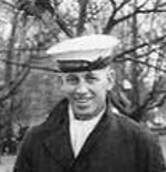 Percival James Cameron
Percival James Cameron
As the light faded, the three worst wounded were on the raft whilst others clung to the lanyards or floating debris. During the night, OS Andrew Johnston & ERA William Moffitt became separated from the main group & were never seen again. In the early hours of Saturday the 23rd January, 15 crew & 3 Yolngu including Paddy Babawun, the native pilot from Milingimbi & Narritjin Maymuru from Yirrkala rafted ashore near the NE tip of Guluwuru Island. Babawun, half drowned and shipwrecked scrambled ashore & within a few minutes had miraculously started a fire which revived the spirits and they lay down exhausted and slept until daylights. Stoker Percival James Cameron died of his wounds at about 08:00 & was buried at 10:00 in a shallow grave dug out by hand and with the canoe paddles. At about 14:00 - Milirrma also died and was buried beside Percy. Flags of sandstone were piled above them & perhaps a canoe paddle set up for a grave marker. Narritjin had also dived to avoid the gunfire & although badly concussed and groggy for a few days but emerged unscathed and went on to international renown as an artist.
 C/O of Pat Cam Alexander Meldrum
C/O of Pat Cam Alexander Meldrum
Despite his sunburn and tropical rot, Capt. Meldrum decided to leave his crew and join the Yolngu party in crossing the Cumberland Strait to embark upon a barefoot trek to raise the alarm at Jensen Bay. At the subsequent inquiry, it was this decision to walk to Jensen Bay that mitigated against facing a court marshal for having inadequate & ill-equipped men on watch whilst in enemy contested waters and having an improperly provisioned life raft.
At 21:00hrs on Tuesday 26th January, Meldrum & guides arrive at Jensen Bay. Due to bad atmospherics & low batteries it was not until 09:30 the next morning that Meldrum's message was transmitted by coastwatcher Jack Jensen - it was heard by Thornell at Yirrkala but not received by Darwin. Jensen knew of a daily flight out of Horn Island that set out to look for the expected Japanese invasion fleet. Their orders being to report immediately in normal language and expect to be shot down.
At 21:00hrs on Tuesday 26th January, Meldrum & guides arrive at Jensen Bay. Due to bad atmospherics & low batteries it was not until 09:30 the next morning that Meldrum's message was transmitted by coastwatcher Jack Jensen - it was heard by Thornell at Yirrkala but not received by Darwin. Jensen knew of a daily flight out of Horn Island that set out to look for the expected Japanese invasion fleet. Their orders being to report immediately in normal language and expect to be shot down.
Their triangular track brought them back from north of the TIWI Islands across Cape Wessel. Jensen frantically carved messages in the sand and was gesticulating violently at 11:00 when spotted by RAAF Beaufort A9-108 piloted by PO Len Gairns came over in a low level pass.
Gairns wrote "I saw this bearded white man on the beach, waving furiously. He looked like Moses. He was not a sailor; I never learned who he was".
Gairns wrote "I saw this bearded white man on the beach, waving furiously. He looked like Moses. He was not a sailor; I never learned who he was".
It was Petty Officer Winston John 'Jack' Jensen {Special Intelligence Service} Naval Coastwatcher - Gairns dropped a message & did another circuit whilst Jensen drew an arrow in the sand sending the plane 25 miles southward to find the survivors who had carved PATCAM BOMBED, HAVE WATER & NO FOOD - Gairns dropped the few rations he had on board & another message asking 5 questions. Further rations were dropped next day by Gairns in A9-122 when at 1000 feet he took this photograph of the answers to his questions. He conducted a box search of the area but found no additional survivors or wreckage. Every day thereafter rations, clothes & equipment were dropped by PO A.A. Cambridge from a Hudson out of Milingimbi. The large floating tin was an empty water tank that had been on the Pat Cam's deck.
Unwilling to break radio silence on pain of court-marshal, Gairns waited until he could report personally to RAAF intelligence officer Alf Wilson at Horn Island - at long last a coded message was sent from N.O.I.C. Port Darwin to the Navy Board and passed to C.S.W.P. General MacArthur and word of the sinking had got out. Nobody had thought that the failure to hear from the vessel or receive any reports from Jensen Bay was anything unusual. Her subsequent failure to arrive at Yirrkala was also ignored. Alf Wilson was to do a stint with MacArthur's team as it moved north with the war and it was his contacts with the US team that facilitated the unravelling of the fate of Leonard Kentish.
 HMAS Kuru getting a well deserved bogey.
HMAS Kuru getting a well deserved bogey.
In the absence of suitable vessels or Catalina flying boats - HMAS Kuru, under Coupe's command, sailed from Darwin at midnight on 27th January with a doctor aboard - the day the news of the disaster broke.
Kuru arrived at the Wessels in a downpour late on Friday 29th where departure was tinged with sadness at leaving their shipmates Percy Cameron & Milirrma Marika.
Guided in the moonlight by the Yolngu they sailed up to Jensen Bay to collect Meldrum - arriving back in Darwin at 10:00 on Monday 1st February 1943. Kuru had also been built by Gordon Beattie who built the Pat Cam and this escapade was not the least of her heroic adventures during the war - her curious story is detailed below.
Kuru arrived at the Wessels in a downpour late on Friday 29th where departure was tinged with sadness at leaving their shipmates Percy Cameron & Milirrma Marika.
Guided in the moonlight by the Yolngu they sailed up to Jensen Bay to collect Meldrum - arriving back in Darwin at 10:00 on Monday 1st February 1943. Kuru had also been built by Gordon Beattie who built the Pat Cam and this escapade was not the least of her heroic adventures during the war - her curious story is detailed below.

Photographed in front of the Naval Wing at the Kahlin Hospital on 29 January 1943, HMAS Melville Darwin. Identified are (front row) L-R: Stoker Arthur R. Bennett RANR of Melbourne, Victoria; Able Seaman (AB) Greg Durrington RANR of Sydney, NSW; Telegraphist Bert R.L. Stevens of Sydney, NSW; Steward Alfred R. Tanner RANR of Melbourne, Victoria. (standing) AB Don D. Brun RANR of Adelaide, SA; Stoker George W. W. Williams RANR of Melbourne, Victoria; Ordinary Seaman Vivian D. Murray RANR of Mackay, Queensland; Sub Lieutenant John Leggoe RANVR of York, WA; Cook John R. Hawkins RANR of Melbourne, Victoria; Lieutenant Alexander C. Meldrum RANR of Sydney, NSW (C/O of Pat Cam); Petty Officer Hulbert G. Challender RAN of Hobart, Tasmania; AB Aubery R. White RANR of Perth, Western Australia and Engine Room Artificer John D. McKimmie RANR of Launceston, Tasmania. n.b. Acting AB M. R. Levett RANR was too ill - below see image of him in a hospital bed being visited by Murray.
 Boom Yard sheds (bottom central)
Boom Yard sheds (bottom central)
The Board of Enquiry was convened at 0900 on Thursday 4th February at H.M.A. Boom Defence Depot in Darwin. Lt. Commander Meldrum presented a written account and responded to questions including a description of the deaths and burials of Percy Cameron and Gitjbapuy.
The board was concerned with the question of whether or not to charge Meldrum over the loss of his ship - in view of his forced march he was commended instead. Sun visors were ordered immediately for lookouts on all vessels serving in tropical waters.
However, the major concern was whether or not the Pat Cam was lying in such shallow waters that Japanese pearl divers could arrive on a floatplane or submarine and successfully remove the code books from the perforated tin in the captain's locked desk.
There is no mention of looking for Moffitt & Johnston or of recovering the remains of Stoker Percy Cameron.
The board was concerned with the question of whether or not to charge Meldrum over the loss of his ship - in view of his forced march he was commended instead. Sun visors were ordered immediately for lookouts on all vessels serving in tropical waters.
However, the major concern was whether or not the Pat Cam was lying in such shallow waters that Japanese pearl divers could arrive on a floatplane or submarine and successfully remove the code books from the perforated tin in the captain's locked desk.
There is no mention of looking for Moffitt & Johnston or of recovering the remains of Stoker Percy Cameron.
Within a week the survivors were away to their home ports and dispersed throughout the fleet. The war and everyone in it moved relentlessly northwards & the loss of the 'small ship' Patty Cam was forgotten. Percy Cameron was officially 'lost at sea'. On the fifth of February, following an Allied air raid, the Reverend Len Kentish was beheaded by Dobo base commander Sagejima Mangan, assisted by P.O. Kenzo Hoyama & civilian Shozuke Kohama. It would be years before Violet Kentish would learn of her husband's fate in the newspapers and before his remains were given a decent burial.
 Murray & Levett at Naval Wing of Kahlin Hospital Darwin.
Murray & Levett at Naval Wing of Kahlin Hospital Darwin.
Stoker Percy Cameron's daughter Janice Lee was only two years old when he died. Her mother never spoke of him and his family became strangers in the way that only family can. In her 18th year Janice enrolled in evening classes, as was the Sydney fashion of the day, and she found herself in an enrolment line before a man who was to teach woodworking - he asked her name & when she said Janice Lee Cameron he said "I buried your father and named my daughter for you". She believed that it was stoker Arthur Robert Bennett but this now seems unlikely - many years later a survivor would visit Meldrum in Perth and they would share a bottle of single malt - it became an annual event and no doubt Percy & Milirrma's majestic isolation prompted much reflection & toasts. Bennett had told Meldrum that he should have stayed up with Percy that night long ago and been there with him when, like the Pat Cam, he had slipped away.
In the image above, Arthur Bennett is shown holding a native paddle - there is another in storeroom No. 2 at HMAS Larrakia in Darwin which bears a brass plaque -"A Captain's Paddle" - was it Meldrum's walking stick on the trek to Jensen Bay? Unfortunately Department of Defence has banned any of its personnel from speaking about the Pat Cam or acknowledging discovery of the location of the island where Percy & Gitjbapuy are buried. Perhaps one day a more mature attitude will prevail and this item, amongst many others, may be to added to the nation's heritage. The ship's relics removed from the Frances Bay wreck of the Huddersfield (more likely the Rachel Cohen) in Darwin harbour in 1996, are a case in point.
In the image above, Arthur Bennett is shown holding a native paddle - there is another in storeroom No. 2 at HMAS Larrakia in Darwin which bears a brass plaque -"A Captain's Paddle" - was it Meldrum's walking stick on the trek to Jensen Bay? Unfortunately Department of Defence has banned any of its personnel from speaking about the Pat Cam or acknowledging discovery of the location of the island where Percy & Gitjbapuy are buried. Perhaps one day a more mature attitude will prevail and this item, amongst many others, may be to added to the nation's heritage. The ship's relics removed from the Frances Bay wreck of the Huddersfield (more likely the Rachel Cohen) in Darwin harbour in 1996, are a case in point.
 Percy Cameron
Percy Cameron
Percy Cameron's wife was widowed at twenty-three and passed away many years ago. For their daughter Janice, life moved on but, though she never followed up the meeting with the man she took for Bennett, she did meet the 2-I-C of the Pat Cam, John Leggoe, who wrote a full account in "Trying to be Sailors" - specifically detailing the burials in the Wessel Islands. Jan wrote repeatedly to the Navy & Defence but each time was "fobbed off" with the official Lost at Sea line, having no known grave which is how he is recorded at the Canberra War Memorial & the Commonwealth memorial at Plymouth.
There is no evidence to suggest any effort was ever made to recover the remains of Percy Cameron and despite the abovementioned accounts - Defence has steadfastly maintained to Percy Cameron's daughter, Jan Braund - that her father was lost at sea despite first-hand account & sworn evidence to its own board of inquiry. The feature article I want Him Home by Lisa Clausen recounts how the PastMasters brought the story back into the daylight.
Image shows Percy in tropical rig at Darwin wearing the HMAS Melville cap tally. n.b. wristwatch.
There is no evidence to suggest any effort was ever made to recover the remains of Percy Cameron and despite the abovementioned accounts - Defence has steadfastly maintained to Percy Cameron's daughter, Jan Braund - that her father was lost at sea despite first-hand account & sworn evidence to its own board of inquiry. The feature article I want Him Home by Lisa Clausen recounts how the PastMasters brought the story back into the daylight.
Image shows Percy in tropical rig at Darwin wearing the HMAS Melville cap tally. n.b. wristwatch.
Government efforts to minimise public knowledge of combat activity in Northern Australia were persistently undermined by relatives of civilians who lost their lives in the bombing of Darwin on 19th February 1942 and in subsequent raids. The requests for information and return of personal effects were directed at the political level and could not as easily be ignored by the armed services. Many of the deceased, such as those at Frogs Hollow, could be dismissed as vagrants but there were others whose respectable families in Cairns and the UK who were persistent. Likewise, whilst the many bodies in the swamp were guarded jealously by crocodiles there was the body of a US Navy person called 'Coop or Cock' (Cook probably) and another cadaver with a wrist adorned by a gold Rolex watch. The Directorate of Graves Registration at Victoria Barracks in Melbourne was responsible for identifying the final resting place of servicemen and obliged to match the missing list to the cemetery list. It was during the fruitless pursuit of the bodies of three RAN crew from HMAS Swan that the Police were asked to assist and their enquiries revealed the reason behind the Navy's failure to even attempt to recover Percy Cameron or any other truant graves was that they had deliberately scrapped all files prior to the 25th February 1942.
In summation there is the RAN's neglect of the remains of Percival James Cameron, Alwyn John Breen, Albert Samuel Purdon & John Sault. There is the 70 years of official denial of evidence in published first hand accounts and there is denial and concealment of sworn testimony to its own Board of Enquiry. The Darwin blitz was an unprecedented opportunity to lose embarrassing records so there must be grounds for speculation as to what enigmatic intelligence or magnitude of cock up would warrant the frantic destruction of files within a week of the raids.
In summation there is the RAN's neglect of the remains of Percival James Cameron, Alwyn John Breen, Albert Samuel Purdon & John Sault. There is the 70 years of official denial of evidence in published first hand accounts and there is denial and concealment of sworn testimony to its own Board of Enquiry. The Darwin blitz was an unprecedented opportunity to lose embarrassing records so there must be grounds for speculation as to what enigmatic intelligence or magnitude of cock up would warrant the frantic destruction of files within a week of the raids.
Additional Information & Images
The Rescue of Clarence Sanford USAF
'We found a white man on an island long ago'
 Clarence E. Sanford USAF
Clarence E. Sanford USAF
75 years ago, on 14 March 1942 a raw 23 year old American Kitty Hawk pilot, Clarence 'Sandy' Sanford, took off from Horn Is. to engage the first Japanese attack on Nth Qld. After inflicting damage on 2 Zeros & suffering damage to himself & his plane - Sanford was disorientated in cloud & began a 1000km jaunt across the Gulf of Carpentaria to parachute into the sea & be rescued from Bremer Is. by 3 Marika men from Yirrkala.
He survived through luck, a crucifix & Yolngu bush craft, going on to have a long career as a surgeon. From Cape York to New York was a hell of a journey - Sandy Sanford in gratitude we salute you.
One of Sanford's rescuers, lost his life on HMAS Patricia Cam & plaques commemorating these events will be unveiled on 24th April at Yirrkala.
He survived through luck, a crucifix & Yolngu bush craft, going on to have a long career as a surgeon. From Cape York to New York was a hell of a journey - Sandy Sanford in gratitude we salute you.
One of Sanford's rescuers, lost his life on HMAS Patricia Cam & plaques commemorating these events will be unveiled on 24th April at Yirrkala.
The Reverend Leonard Kentish (1907 - 1943)
 Emigrant Ship Canton
Emigrant Ship Canton
James Kentish (36), a grocer of Peckham, London & his wife Elizabeth (36) - emigrated to Australia in 1838 - arriving at Adelaide on the 2nd May with six children - David Joel (13); Elizabeth (12); Charles (8); Henry (7) & Emma Mary (2) plus James (15) also son of James Snr - he travelled under different but consecutive Application & Embarkation numbers.
They took passage upon the 506 ton Canton which was just 4 years old when she left London & Plymouth in April 1838 under command Capt. J. Mordaunt carrying supercargo of 83 adults & 60 children to join the 6,000 settlers already in the new colony of South Australia.
A letter of appreciation of Capt. Mordaunt, signed by many passengers was published on 8th May 1838.
They took passage upon the 506 ton Canton which was just 4 years old when she left London & Plymouth in April 1838 under command Capt. J. Mordaunt carrying supercargo of 83 adults & 60 children to join the 6,000 settlers already in the new colony of South Australia.
A letter of appreciation of Capt. Mordaunt, signed by many passengers was published on 8th May 1838.
 Len Kentish at King's 1931
Len Kentish at King's 1931
Leonard Noel Kentish was born at Richmond in Melbourne on 28th August 1907 - one of eight children to Cecil Wallace Kentish (1868-1940) & Alice Flora {nee Jackson 1873-1955}. In 1909 the Kentish family led a migratory trek of 200 families from Victoria into Southern Queensland, under the Queensland Government Group Settlement Scheme, settling as pioneer graziers at The Gums in the Tara district, near Dalby.
Between land clearing and farming, Len attended school at The Gums, then Dalby State High School, passing the Junior Public Examination. Drought & prickly pear had forced the family to move to Bundamba near Ipswich in 1923. After working briefly in the State Public Service as a clerk, he volunteered as a Methodist Home Missionary, at Mitchell in 1927. The following year he transferred to Woodford where he met Violet and they were engaged by the end of 1928.
As a candidate for the Ordained Ministry and under the guidance of the Master of King's College, Len matriculated at 18 & entered the University of Queensland. At King's College he gained his BA Hons in mental & moral philosophy. He won a fourth year scholarship & college 'blues' in rugby, cricket, tennis & athletics. In the fourth year he began a Bachelor of Divinity through the Melbourne College of Divinity - was College Club president - lectured in Greek & Hebrew and was a member of the College's rowing four. He worked as second minister at Indooroopilly Methodist Circuit while completing his honours thesis for the BA degree.
On completion of his studies & during preparation for ordination, he married Violet May Simpson on 31st March 1934 in Maryborough (QLD) and they moved to the Hermit Park Church in the Townsville Methodist Circuit. In 1935 Len took up Overseas Missions in the joint European & Aboriginal Missions in Darwin. In that year his first child Noel was born and he found himself increasingly working with Aboriginal people at the Kahlin & later the Bagot compound. Whist in Darwin he completed his Batchelor of Divinity degree & Accountancy qualifications.
Between land clearing and farming, Len attended school at The Gums, then Dalby State High School, passing the Junior Public Examination. Drought & prickly pear had forced the family to move to Bundamba near Ipswich in 1923. After working briefly in the State Public Service as a clerk, he volunteered as a Methodist Home Missionary, at Mitchell in 1927. The following year he transferred to Woodford where he met Violet and they were engaged by the end of 1928.
As a candidate for the Ordained Ministry and under the guidance of the Master of King's College, Len matriculated at 18 & entered the University of Queensland. At King's College he gained his BA Hons in mental & moral philosophy. He won a fourth year scholarship & college 'blues' in rugby, cricket, tennis & athletics. In the fourth year he began a Bachelor of Divinity through the Melbourne College of Divinity - was College Club president - lectured in Greek & Hebrew and was a member of the College's rowing four. He worked as second minister at Indooroopilly Methodist Circuit while completing his honours thesis for the BA degree.
On completion of his studies & during preparation for ordination, he married Violet May Simpson on 31st March 1934 in Maryborough (QLD) and they moved to the Hermit Park Church in the Townsville Methodist Circuit. In 1935 Len took up Overseas Missions in the joint European & Aboriginal Missions in Darwin. In that year his first child Noel was born and he found himself increasingly working with Aboriginal people at the Kahlin & later the Bagot compound. Whist in Darwin he completed his Batchelor of Divinity degree & Accountancy qualifications.
 Len & Elaine Sept 1938
Len & Elaine Sept 1938
In 1940, after three years in Darwin, Len was appointed Chairman of the Methodist Overseas Missions' North Australia District, which position he continued to hold when he moved to the mission station on South Goulburn Island. On Goulburn Is. he worked on his Master of Arts Thesis, but gave priority to developing a written language in the local Maung dialect. He contribute to Church journals including "Sawdust in the dinner", in the Missionary Review, 5 April 1939 - "Sea Slugs and Crocodiles" and "The Witness of North Australia" both in the Queensland Methodist Times, 17 March 1838 and 23 October 1941 respectively.
With the outbreak of war & threat of Japanese invasion, Len Kentish became the senior member of the voluntary Coastwatchers. His wife Violet and children Noel, Elaine, Jackson & Judith travelled though Mataranka, Alice Springs, Adelaide and Melbourne before reaching Brisbane where they lived with his mother in Paddington, as they waited for Len to join them. (Sources inc. Australian Saints BlogSpot & the NT Dictionary of Biography - Ancestry.com & MyHeritage.com & QueenslandPlaces.com - checked by Noel Kentish)
With the outbreak of war & threat of Japanese invasion, Len Kentish became the senior member of the voluntary Coastwatchers. His wife Violet and children Noel, Elaine, Jackson & Judith travelled though Mataranka, Alice Springs, Adelaide and Melbourne before reaching Brisbane where they lived with his mother in Paddington, as they waited for Len to join them. (Sources inc. Australian Saints BlogSpot & the NT Dictionary of Biography - Ancestry.com & MyHeritage.com & QueenslandPlaces.com - checked by Noel Kentish)
 AWM P10575-005 Kaiwo Maru 1936
AWM P10575-005 Kaiwo Maru 1936
The Japanese pearlers had good charts of the Top End coast, having gathered intelligence during ten years working the Tiwi Islands & Arnhem Land with Darwin as a base. The fleet monitored ships entering & leaving Darwin harbour during a period of appeasement that saw token policing by Haultain et al in Larrakia. Len Kentish was well known to the Japanese community in Darwin, as he often assisted the bereaved families of pearl divers. His distinctive voice would have been easily recognisable over the radio. Every Japanese mother ship & many of the larger pearling luggers carried radios.
A Japanese sail training vessel Kaiwo (Kaiō) Maru visited in 1936 when cadets with camera in hand were escorted throughout Darwin port & shore defences and permitted to photograph everything. The officers presented a memorial to mark the occasion of the visit by the ship of the Greater Japan Government - it was a traditional grave marker from the hold of the ship, plastered, signed by the officers and placed outside the Japanese Club. The club & memorial were duly skittled during the war & it has ended up somewhat incongruously at the museum of the Chung Wah Society in Darwin.
A Japanese sail training vessel Kaiwo (Kaiō) Maru visited in 1936 when cadets with camera in hand were escorted throughout Darwin port & shore defences and permitted to photograph everything. The officers presented a memorial to mark the occasion of the visit by the ship of the Greater Japan Government - it was a traditional grave marker from the hold of the ship, plastered, signed by the officers and placed outside the Japanese Club. The club & memorial were duly skittled during the war & it has ended up somewhat incongruously at the museum of the Chung Wah Society in Darwin.

Len Kentish was also profoundly deaf, which may have not endeared him to his captors, although it is reported that his execution followed a bombing run on the Japanese base where he was captive. All reporting of the loss of the Pat Cam was suppressed in an effort to keep Kentish's coastwatcher duties secret. His shipwrecked shipmates adrift in the Arafura Sea as night fell believed that the Missionary would be the only one to survive.
"Understand Captain North U.S. military censorship liaison officer Melbourne is forwarding to military censor G.H.Q. newspaper stories of sinking of H.M.A.S. Patricia Cam for advice regarding publication. Request you inform commander McCollum and request he represent strongly to G.H.Q. naval board’s desire no repetition no publication of this material or any other reference loss H.M.A.S. Patricia Cam. Any release of story seriously jeopardise fate of missionary who although civilian was naval coast watcher."
Noel Kentish recalls - "I will never forget the sense of sad relief my mother experienced on knowing that my father's remains had been recovered at Dobo. Even his work as a coastwatcher was a combined effort of his Maung Aboriginal lookouts and his dedicated work on the AWA radio transceiver that occupied a corner of his study area at Warruwi".
After the war, Len Kentish's wife Violet, on the advice of Alf Wilson, wrote to all capital city newspapers seeking word of her husband from returning PoW's. By an extraordinary twist of fate her letter landed on the desk of John Leggoe at the West Australian and he was able to lodge a statement before the Commonwealth Crown Solicitor, Fred Whitlam - father of future prime minister Gough Whitlam. It was not until late 1946 that she learned of her husband's fate. Phil Herdman of Arnhemland Historical Society has a Defence Department memorandum which states “we probably don’t have to notify the widow as she would have read about it in the paper.” Despite her husband's death on active duty, it took some considerable time before she received any war widow's benefit. The Yolngu were never acknowledged - their names were not discovered and neither medals nor payment received similar to the other Aboriginal units across the Top End. No record has been found of Paddy Babawun's service being formally acknowledged nor any pay accruing.
"Understand Captain North U.S. military censorship liaison officer Melbourne is forwarding to military censor G.H.Q. newspaper stories of sinking of H.M.A.S. Patricia Cam for advice regarding publication. Request you inform commander McCollum and request he represent strongly to G.H.Q. naval board’s desire no repetition no publication of this material or any other reference loss H.M.A.S. Patricia Cam. Any release of story seriously jeopardise fate of missionary who although civilian was naval coast watcher."
Noel Kentish recalls - "I will never forget the sense of sad relief my mother experienced on knowing that my father's remains had been recovered at Dobo. Even his work as a coastwatcher was a combined effort of his Maung Aboriginal lookouts and his dedicated work on the AWA radio transceiver that occupied a corner of his study area at Warruwi".
After the war, Len Kentish's wife Violet, on the advice of Alf Wilson, wrote to all capital city newspapers seeking word of her husband from returning PoW's. By an extraordinary twist of fate her letter landed on the desk of John Leggoe at the West Australian and he was able to lodge a statement before the Commonwealth Crown Solicitor, Fred Whitlam - father of future prime minister Gough Whitlam. It was not until late 1946 that she learned of her husband's fate. Phil Herdman of Arnhemland Historical Society has a Defence Department memorandum which states “we probably don’t have to notify the widow as she would have read about it in the paper.” Despite her husband's death on active duty, it took some considerable time before she received any war widow's benefit. The Yolngu were never acknowledged - their names were not discovered and neither medals nor payment received similar to the other Aboriginal units across the Top End. No record has been found of Paddy Babawun's service being formally acknowledged nor any pay accruing.
|
|
|
||||||||||||||||||
War Crimes Trial - Hong Kong 1948
On 21 May 1948 at Kowloon, Hong Kong. The International Military Tribunal for the Far East began a war crimes trial to prosecute three Japanese prisoners (two members of the Imperial Japanese Navy and one civilian Administrator) had been charged with the murder of the Australian missionary, the Reverend Leonard Neil Kentish, on 4th May 1943.
On 29th August 1946 the Adjutant of 3 Australian Prisoner of War Contact and Enquiry Unit reported on the circumstances of the Reverend Leonard Kentish’s death at Dobo in the Aru Islands (now part of Indonesia):
1. The Rev KENTISH was taken on board a Jap float plane on Jan 22 43 after it had sunk the patrol vessel HMAS “PATRICIA CAM” off WESSEL IS.
2. Unfortunately no info can be obtained of the whereabouts of the Rev KENTISH until 13 Apr 43, when he arrived at DOBO.
3. The Rev KENTISH was held at DOBO as a prisoner till the 4 May 43. Throughout this period he was subjected to ill treatment by severe bashings, the most common being punches in the nose and eyes to such an extent that his nose was broken, and he had great difficulty in seeing. His diet, as such, was just sufficient to keep him alive.
4. On the morning of 4 May he was taken in to the scrub, (a distance of under 200 yds from the township of DOBO) where a grave had been prepared, and executed.
5. The execution was carried out by the order of 1st Lieut SAKIDJIMA.
6. The remains of the Rev KENTISH have been recovered, and handed over to Capt. STOCKWELL, of the War Graves Unit. They will be transported to AMBON, and buried in the Internees cemetery there.
7. This case is now considered closed.
On 29th August 1946 the Adjutant of 3 Australian Prisoner of War Contact and Enquiry Unit reported on the circumstances of the Reverend Leonard Kentish’s death at Dobo in the Aru Islands (now part of Indonesia):
1. The Rev KENTISH was taken on board a Jap float plane on Jan 22 43 after it had sunk the patrol vessel HMAS “PATRICIA CAM” off WESSEL IS.
2. Unfortunately no info can be obtained of the whereabouts of the Rev KENTISH until 13 Apr 43, when he arrived at DOBO.
3. The Rev KENTISH was held at DOBO as a prisoner till the 4 May 43. Throughout this period he was subjected to ill treatment by severe bashings, the most common being punches in the nose and eyes to such an extent that his nose was broken, and he had great difficulty in seeing. His diet, as such, was just sufficient to keep him alive.
4. On the morning of 4 May he was taken in to the scrub, (a distance of under 200 yds from the township of DOBO) where a grave had been prepared, and executed.
5. The execution was carried out by the order of 1st Lieut SAKIDJIMA.
6. The remains of the Rev KENTISH have been recovered, and handed over to Capt. STOCKWELL, of the War Graves Unit. They will be transported to AMBON, and buried in the Internees cemetery there.
7. This case is now considered closed.
All three of the prisoners were Lieutenant Sagejima Mangan (Farmer) & PO Kenzo Hoyama and one civilian Administrator attached to the Imperial Navy Shozuke Kohama. All pleaded not guilty to the charge of "COMMTTING A WAR CRIME in that they at DOBO in the AROE Islands on 5February 1943 were, in violation of the laws and usages of war, together concerned in the unlawful killing of the Rev. LEONARD KENTISH an Australian civilian internee, then held in the custody of the Japanese armed forces."
Sagejima's record of interview stated that Kentish was placed in his charge when the seaplane unit left Dobo. That Dobo was heavily bombed some two weeks afterwards killing 2 of his unit & injuring 8 others. Enraged, he resolved to kill the prisoner. He borrowed a sword from Kohama and at twilight that day Kentish was taken a short distance to a bomb crater where Sagejima personally executed the prisoner by decapitation. Kohama was a witness. On hearing that Kohama had given evidence, Sagejima confessed, having received no instructions from higher authorities and not reporting the incident to senior command.
Sagejima's record of interview stated that Kentish was placed in his charge when the seaplane unit left Dobo. That Dobo was heavily bombed some two weeks afterwards killing 2 of his unit & injuring 8 others. Enraged, he resolved to kill the prisoner. He borrowed a sword from Kohama and at twilight that day Kentish was taken a short distance to a bomb crater where Sagejima personally executed the prisoner by decapitation. Kohama was a witness. On hearing that Kohama had given evidence, Sagejima confessed, having received no instructions from higher authorities and not reporting the incident to senior command.

Testimony from John Leggoe was tabled "The float plane approached and as we thought we may be machine-gunned several of us swam away from the raft and spread out. By the time the float plane alighted the Rev. Kentish had swum to the edge of the circle of wreckage and the plane taxied up to where he was floating. Two of the plane's crew moved to the floats and beckoned to Rev. Kentish. I saw him being dragged aboard and the plane then took off with him." Peter Leggoe's recalled that this event troubled his brother down the years, feeling that he should have volunteered himself as they obviously wanted an officer but he wasn't to know that Kentish would not see out the war as a prisoner whilst his own position in the Arafura Sea was dire in the extreme.
John Leggoe wrote in his testimony at Perth W.A. on 17th September 1947 - "I recognise the photograph now produced and shown to me and marked "A" as being that of the said Rev. Kentish." This is the photograph shown to John Leggoe.
John Leggoe wrote in his testimony at Perth W.A. on 17th September 1947 - "I recognise the photograph now produced and shown to me and marked "A" as being that of the said Rev. Kentish." This is the photograph shown to John Leggoe.
In his petition Sagejima Mangan wrote "I made a decision to kill a European at Dobo for the reasons I have stated in my evidence. I was conscript W.O. at the time and had no superior officer to turn to for guidance. We were being blasted mercilessly by the enemy and the situation appeared pretty hopeless. I have accepted full responsibility for my actions and have realised since the event that my actions were extremely rash but I was not of that opinion at the time."
Kenso Hoyama's family petitioned Douglas MacArthur to allow him to be imprisoned at Hiroshima to be close to his aged mother whose health was fading.
On 4th August 1948 the court's findings of Guilty and the sentence of Death by Hanging were confirmed - Hoyama & Kohama's sentences were commuted to Imprisonment for Life but Sagejima was hanged at Stanley Prison before 0800hrs on Tuesday 24th August 1948 and that afternoon his remains were buried at sea.
Kenso Hoyama's family petitioned Douglas MacArthur to allow him to be imprisoned at Hiroshima to be close to his aged mother whose health was fading.
On 4th August 1948 the court's findings of Guilty and the sentence of Death by Hanging were confirmed - Hoyama & Kohama's sentences were commuted to Imprisonment for Life but Sagejima was hanged at Stanley Prison before 0800hrs on Tuesday 24th August 1948 and that afternoon his remains were buried at sea.
Discovery of the Pat Cam Survivors Beach
 One of the Kilwa Coins courtesy PowerHouse Museum NSW
One of the Kilwa Coins courtesy PowerHouse Museum NSW
The Past Masters 2013 Ancient Coins in Arnhemland Expedition went in search of the site where a cache of 900 year old Kilwa coins was discovered by radar operator Morrie Isenberg in 1944. On the last day the group visited Japanee Creek which even today receives a good deal of attention from Indonesian fishermen. During the pre-war Japanese pearling days (see below) - the Wessels provided shell and abundant freshwater away from Government oversight. Burramurra worked in a pearling camp on Jensen Island during this period and the team found evidence of this camp.
Until Cyclone Monica this was a very large freshwater, Paperbark swamp with a substantial creek that would be open during the Wet and provide excellent cyclone shelter as well as abundant food & water. Sadly the saltwater incursion has killed all the trees. The creek is called Mitjianguru meaning The Place of the Boat but from a much more distant past - it is an excellent spot to look for wrecks using remote sensing.
Until Cyclone Monica this was a very large freshwater, Paperbark swamp with a substantial creek that would be open during the Wet and provide excellent cyclone shelter as well as abundant food & water. Sadly the saltwater incursion has killed all the trees. The creek is called Mitjianguru meaning The Place of the Boat but from a much more distant past - it is an excellent spot to look for wrecks using remote sensing.
Whilst field walking the strand line at the mouth of the creek, Past Masters' principal archaeologist Michael Hermes discovered this ship's beam knee and it was this relic that lead Mike Owen to investigate the potential for it being from the wreck of the Pat Cam.
Subsequent analysis of a single, good sized sample by Jugo Ilic (Know Your Wood) identified as being genus Agalia which has >100 species of which sapindina was suggested as a likely candidate. "The species are very widespread from Burma across SE/Asia and the wood has been used for boat building." On the other hand, the fixings have been identified as being identical to those used on the Pat Cam and too sophisticated for SE Asian origin. It was original postulated that the piece emanated from the wreck of a vessel that has south shelter up the Japanee Creek and the piece therefore had not had far to travel. The freshwater environment may have preserved it from Toledo worm attack. Up until recent years such timber would normally be burnt by Aboriginal people as firewood. Today it would be lost in periodic bushfires. Irrespective of its origin, it was this find that led Mike Owen to identify the last resting place of Stoker Percy Cameron and Yolngu auxiliary coastwatcher Gitjbapuy.
Subsequent analysis of a single, good sized sample by Jugo Ilic (Know Your Wood) identified as being genus Agalia which has >100 species of which sapindina was suggested as a likely candidate. "The species are very widespread from Burma across SE/Asia and the wood has been used for boat building." On the other hand, the fixings have been identified as being identical to those used on the Pat Cam and too sophisticated for SE Asian origin. It was original postulated that the piece emanated from the wreck of a vessel that has south shelter up the Japanee Creek and the piece therefore had not had far to travel. The freshwater environment may have preserved it from Toledo worm attack. Up until recent years such timber would normally be burnt by Aboriginal people as firewood. Today it would be lost in periodic bushfires. Irrespective of its origin, it was this find that led Mike Owen to identify the last resting place of Stoker Percy Cameron and Yolngu auxiliary coastwatcher Gitjbapuy.
The Navy website displays an aerial photograph of the survivors on the beach. Obvious inconsistencies between the image and text prompted analysis which identified further anomalies and signature features that enabled the location of the beach to be conclusively identified. The website also recommends John Leggoe's work "Trying to be sailors" and when the detailed description was applied to the image it appeared that immediately above the raft there was seemingly a mound marked by a straight line - a paddle - a grave marker. The Department of Defence was publicly displaying an image of Percy Cameron's grave site and referencing a first hand account of his burial whilst still maintaining to his daughter that he was "Lost at Sea".
Attempts to source a high resolution copy of the image from the Navy website met with the customary silence. Individual naval personnel were naturally fascinated and many lines of enquiry were open including into an Aboriginal canoe paddle with a brass plaque at Storeroom 2 at HMAS Coonawarra in Darwin - on a hunch it was thought that maybe Bennett's paddle would be hanging behind a mess bar. Contact had been made with Brian Manns of the Army's Unrecovered War Casualties unit - with Chris Appleton of the Office of Australian War Graves who suggested notifying Vice-Admiral Griggs, head of Navy. NT Coroner Greg Cavanagh's office and Senator Nigel Scullion, Federal Minister for Indigenous Affairs were contacted as the interests of Gitjbapuy's family deserved consideration. It became increasingly obvious that Defence had closed ranks and not even local Naval staff would return calls. On Monday the third of February 2014 an email was sent to enclosing a letter for Griggs advising of the discovery and precise location of the beach and suspected graves. A similar letter was emailed to Senator Scullion. In both instance telephone calls were made to confirm receipt - no acknowledgement of any sort has ever been received from Defence Department - a level of behaviour which for them is de rigueur.
 Janice Lee Braund
Janice Lee Braund
An article for the Age & Sydney Morning Herald's Good Weekend Magazine was being prepared by Lisa Clausen and it became imperative to contact Percy Cameron's daughter - Janice Lee Braund. On Saturday 8th February a search of the Yellow Pages turned up two Braund's at the same address in Sydney - June Braund said that they were not related but she had just passed Jan Braund's flat, her door was open and if you phone straight away you'll catch her.
The ensuing conversation was followed up by emails and maps. The next day Jan emailed and noted that she had received a call from Kevin Slade of the Navy who was due to visit her on Wednesday but would not say why. Family illness intervened and the Navy did not visit for several weeks.
Over the ensuing months there was considerable publicity and a number of descendants of the crew and those involved in the construction of the Pat Cam came forward. The Dept. Defence prepared to recover the remains of Stoker Percy Cameron.
The ensuing conversation was followed up by emails and maps. The next day Jan emailed and noted that she had received a call from Kevin Slade of the Navy who was due to visit her on Wednesday but would not say why. Family illness intervened and the Navy did not visit for several weeks.
Over the ensuing months there was considerable publicity and a number of descendants of the crew and those involved in the construction of the Pat Cam came forward. The Dept. Defence prepared to recover the remains of Stoker Percy Cameron.
|
|
|
||||||
HMAS Brunei Expedition October 2014
|
|
|
|
|
|
||||||||||||||||||
|
|
|
|
HMAS Kuru
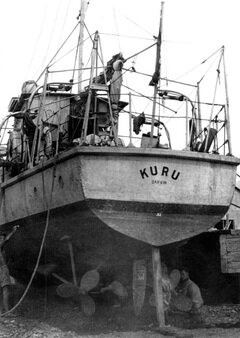 Kuru on navy slipway, Frances Bay, c1947, Lawrence Coffey, NTRS 1705,
Kuru on navy slipway, Frances Bay, c1947, Lawrence Coffey, NTRS 1705,
HMAS Kuru was also built in Balmain by Gordon Beattie in 1938 as a 75ft - 55 ton 'Patrol Boat 78' as the NT Administrator's launch and successor to HMAS Larrakia {a Macassan name for a place of safe anchorage}. The Kuru was to have been built in Singapore but as a Government contract there was the usual political pressure for home construction by the lowest bidder, with the usual result.
Of timber construction, she was built in Balmain by Gordon Beattie in 1938 despite his lack of experience of such high-speed vessels. Echoing a familiar Defence acquisition story, Haultain in "Watch off Arnhem Land" writes that in April 1939 - 'On her maiden voyage she had been forced into Townsville on her way to Darwin, with the hull 'hogged' so badly that she was put on the 'slips' for extensive repairs; the cost of these exceeded her building costs, and she never achieved the speeds for which she had been designed......However, when the Navy took her over she redeemed herself, and had her days of glory.'
The delays of her construction and repairs put back her arrival in Darwin by more than a year and so her time chasing Japanese pearlers & Coast Watch support duties was cut short by the outbreak of hostilities. She was commissioned on 8th December 1941 as a tender for the base ship HMAS Platypus (Penguin) which had been ordered prior to the Great War as a submarine depot ship to support the first Australian submarines AE1 & AE2 - both of which were lost before she was delivered. The Patricia Cam was also assigned to Platypus and her duties included boom defence support.
Of timber construction, she was built in Balmain by Gordon Beattie in 1938 despite his lack of experience of such high-speed vessels. Echoing a familiar Defence acquisition story, Haultain in "Watch off Arnhem Land" writes that in April 1939 - 'On her maiden voyage she had been forced into Townsville on her way to Darwin, with the hull 'hogged' so badly that she was put on the 'slips' for extensive repairs; the cost of these exceeded her building costs, and she never achieved the speeds for which she had been designed......However, when the Navy took her over she redeemed herself, and had her days of glory.'
The delays of her construction and repairs put back her arrival in Darwin by more than a year and so her time chasing Japanese pearlers & Coast Watch support duties was cut short by the outbreak of hostilities. She was commissioned on 8th December 1941 as a tender for the base ship HMAS Platypus (Penguin) which had been ordered prior to the Great War as a submarine depot ship to support the first Australian submarines AE1 & AE2 - both of which were lost before she was delivered. The Patricia Cam was also assigned to Platypus and her duties included boom defence support.
Haultain in 'Watch off Arnhem Land" noted that Kuru never achieved the speeds for which her design and three Thornycroft motors promised but she went on to have a fabled war running Z Special commandos around the Japanese occupied islands on what was known as the Timor Ferry Service. In December 1942 she was in company with HMAS Armidale & Castlemaine to resupply Sparrow Force and evacuate troops & civilians from Betano Bay, on the southern coast of Timor. Armidale & Castlemaine were spotted by Japanese reconnaissance planes and repeatedly attacked during the crossing so missed the rendezvous with Kuru which had been ashore and collected Portuguese refugees before heading back to sea. Some 110kms off the coast they met and transferred the passengers to Castlemaine which headed for Darwin. In broad daylight and their presence known to the enemy, the Armidale & Kuru were ordered by Darwin command to continue the operation in daylight. The presence of two Japanese cruisers sealed Armidale's fate and at 3.15pm on the 1st December 1942 she succumbed to aerial bombardment and sank. Of the 149 aboard, the Captain and 21 crew managed to coax and row a small motor launch half way to Darwin and 29 others set out in the ships whale boat and were eventually picked up north of Bathurst Island. The other survivors took to a raft and were photographed by search aircraft but not recovered. One hundred men lost their lives in the worst Corvette sinking of WW2.
Through the mayhem Kuru dodged in and out of squalls eventually finding herself alone and headed for Darwin until the word spread through the Japanese airfields and everything they had was thrown at the Australian ships........"Kuru was the first to be sighted by searching enemy aircraft - forty-four of them dropped over 200 bombs as well as strafing her. Grant threw her violently from side to side and by some extraordinary dispensation of fate all the bombs missed.
One stick of bombs fell so that Kuru fitted neatly between them. The bomb which fell astern scored a direct hit on the barge which she was towing. The concussion set off a chiming clock in the wheelhouse prompting the quartermaster to yell defiantly, 'Good on you, Tojo; you rang the bloody bell. Give the man a cigar." (John Leggoe - Trying to be Sailors')
One stick of bombs fell so that Kuru fitted neatly between them. The bomb which fell astern scored a direct hit on the barge which she was towing. The concussion set off a chiming clock in the wheelhouse prompting the quartermaster to yell defiantly, 'Good on you, Tojo; you rang the bloody bell. Give the man a cigar." (John Leggoe - Trying to be Sailors')
Kuru was paid off on 22 October 1943. She served as the Government launch post-war and carried many of the NT's iconic characters to remote areas in support of the Patrol Service. She made an immense contribution to Northern Territory including the discovery of bauxite for aluminium that led to the mining at Gove and creation of the town of Nhulunbuy {see below}.
 Kuru at Dina Beach - NTL 10070/5569
Kuru at Dina Beach - NTL 10070/5569
Kuru was taken off the register in 1951 & by 1952 was partly dismantled near Hornibrooks slipway on Dinah Beach when world famous artist Ian Fairweather took up residence in the aft section. He had previously moved out of a cement mixer into a derelict railway carriage at Frances Bay.
On the back-end of the bombed and beached and half-demolished WWII supply-boat the name Kuru still stands proud. Stars thrash through the frayed nets draping its severed deck. In the chart room the painter fumbles for a match, lights and pumps the Tilley.
Gas flares, darkness scuttles to the vault. I know this Spartan space: the sagging table, mismatched paint jars, pencil stubs, battered yellow biscuit tin full of broken chalk and charcoal, zinc tubes tightly rolled so not a smear is wasted and alongside sea-charts, pinned on every section of the splintered walls, calligraphy so tactile I could read it like Braille, worlds of black and white and breathing grey lit by under-painted colour. Fairweather’s shadow crabs across the wall. He fills the kettle from a metal bucket and strikes another match—as if the flame will keep at bay the questions he won’t answer.
On the back-end of the bombed and beached and half-demolished WWII supply-boat the name Kuru still stands proud. Stars thrash through the frayed nets draping its severed deck. In the chart room the painter fumbles for a match, lights and pumps the Tilley.
Gas flares, darkness scuttles to the vault. I know this Spartan space: the sagging table, mismatched paint jars, pencil stubs, battered yellow biscuit tin full of broken chalk and charcoal, zinc tubes tightly rolled so not a smear is wasted and alongside sea-charts, pinned on every section of the splintered walls, calligraphy so tactile I could read it like Braille, worlds of black and white and breathing grey lit by under-painted colour. Fairweather’s shadow crabs across the wall. He fills the kettle from a metal bucket and strikes another match—as if the flame will keep at bay the questions he won’t answer.
Ian Fairweather - The Rear Admiral
 Ian Fairweather
Ian Fairweather
Fairweather earned the handle "The Rear Admiral" for his habitation of Kuru's rear end and became a celebrated Darwin character. Determined to escape he constructed a raft out of drop tanks & parachutes from the tip. In Amorales, his unpublished manuscript of the journey he describes the raft's construction as reported by Dael Allison {see thesis below}:-
'He built the triangular frame from mangrove timber and worm-eaten boards and other flotsam he found along the beaches. To this he bolted three rusting torpedo-shaped aircraft fuel drop-tanks sourced from the tip. A self-confessed junk addict, instead of purchasing strong material for the sail he used two old food parachutes also found at the tip. Made of hessian they were already rotting. He pieced them together into a square sail with a hole in the middle and ribs like a sunburst, similar to his family crest. A good omen, he felt. Bolts, rope and pieces of clothes-line held the whole assemblage together.
For navigation he had a wrist compass. He provisioned with the most basic of supplies; dried bread, milk and oats, sixteen cans of tinned meat and two four gallon kerosene tins and launched his tiny makeshift raft at night to avoid interference from the authorities.'
On the night of 29th April 1952 - at the age of 60 - he slipped out of Darwin harbour to begin his spam fuelled trip to Dili in Timor. As with Percy Cameron, he was officially & erroneously listed as "Lost at Sea" & an obituary published.
'He built the triangular frame from mangrove timber and worm-eaten boards and other flotsam he found along the beaches. To this he bolted three rusting torpedo-shaped aircraft fuel drop-tanks sourced from the tip. A self-confessed junk addict, instead of purchasing strong material for the sail he used two old food parachutes also found at the tip. Made of hessian they were already rotting. He pieced them together into a square sail with a hole in the middle and ribs like a sunburst, similar to his family crest. A good omen, he felt. Bolts, rope and pieces of clothes-line held the whole assemblage together.
For navigation he had a wrist compass. He provisioned with the most basic of supplies; dried bread, milk and oats, sixteen cans of tinned meat and two four gallon kerosene tins and launched his tiny makeshift raft at night to avoid interference from the authorities.'
On the night of 29th April 1952 - at the age of 60 - he slipped out of Darwin harbour to begin his spam fuelled trip to Dili in Timor. As with Percy Cameron, he was officially & erroneously listed as "Lost at Sea" & an obituary published.
 Michael Stevenson's The Gift
Michael Stevenson's The Gift
It soon proved essentially un-sailable and Fairweather abandoned the weighty and useless centreboard. As the triangular deck—just under ten feet (three metres) at its longest—was too unstable to stand on, he had to lie down or sit leaning against the mast. The deck was constantly awash: "I was soaked and very cold. My fingers were swollen, I still had not learnt how to fix the rudder and sail so that the raft would steer itself and I could … scarcely hold the ropes. It was not until the eleventh day that I hit on the combination and so got some much needed rest" (Abbott-Smith, 1978: 109).
His eyes were the worst of the suffering: "They were so painful that, in the end, I could not look at anything in the sunlight or even the stars at night. I had to steer by lying face down and watching the needle of the compass which I shaded with my hand" (ibid.: 110).
Sixteen days of isolation, a journey that was an extreme test of physical endurance, yet the minimalist Fairweather said he drank only half of the water he took and still had food left when he landed on Roti (The Straits Times: 9 August1952).
His eyes were the worst of the suffering: "They were so painful that, in the end, I could not look at anything in the sunlight or even the stars at night. I had to steer by lying face down and watching the needle of the compass which I shaded with my hand" (ibid.: 110).
Sixteen days of isolation, a journey that was an extreme test of physical endurance, yet the minimalist Fairweather said he drank only half of the water he took and still had food left when he landed on Roti (The Straits Times: 9 August1952).
Fairweather ended his days on Bribie Island ,never having made it back to Scotland, the land of his birth. The Darwin Museum & Art Gallery commemorates Fairweather's adventure with an informed walk & - as with Narritjin - by displaying many of his works.
|
|
|
||||||||||||||||||
In November 2016 a new 40 person Seawind 1160 tourist vessel belonging to City of Darwin Cruises will bring the name Kuru back to home waters. She will take passengers on heritage cruises around the harbour to hear about the deeds of HMS Beagle, Goyder, the Overland Telegraph and the glory days of HMAS Patricia Cam and HMAS Kuru 75 years ago when this luxury & ease was purchased for them by other young men at such great cost.
Bauxite - Alumina & the start of Nhulunbuy
During 1949, HB Owen, the senior geologist with Commonwealth Department of National Development was aboard Kuru. The work led to the discovery of 7 mine sites on Marchinbar Island with a potential yield of 4,500,000 tons of alumina or 2,380,000 tons of aluminium metal. His 1953 report says:-
"The writer was fortunate that he travelled from Darwin to Cobourg Peninsula in the Administration’s patrol vessel "Kuru" commanded by Captain F.E. Wells, who knows the Arnhem Land coast intimately. Wells and F.J. Waalkes, a seaman who had had some experience prospecting, were shown specimens of pisolitic laterite and both agreed to continue the search as opportunity offered. Before the end of 1949 many specimens of laterite had been received from Wells and Waalkes jointly and these included fair quality pisolitic bauxite from Truant and the Wessel Islands. Concurrently geologists on the Bureau staff collected laterite specimens from various inland localities in northern Australia, but all of these were too siliceous or too ferruginous to be of use. The writer collated all the information and recommended that the potential resources of Truant and the Wessel Islands should be determined (Owen, 1949b)."
Subsequently in 1952/3 survey work by 25 men sank approx. 550 pits of an average 9ft depth & 27 miles of grid lines were surveyed & pegged - almost half of which required the use of a D4 dozer. The survey identified 7,200,000 tons of bauxite within 2.5 miles of Rocky Point in Jensen Bay. Jack Jensen was caretaker of the mine during this period when Patrol Officer Ted Egan arrived to remove an old Aboriginal man whom Jensen said had run mad & was going to kill him.
"I thought that the only madman at Jensen Bay was Jack, but he was employed as a "caretaker" by the mining company and he was required to stay there. We all camped on the beach that night – there were only Jack, Mugadbuy, the pilot and me on the entire island. A big croc walked right around our camp during the night. Huge tracks on the beach. Mugadbuy was happy to agree with me that Milingimbi was a better place for him at the moment, so we took off, dropped him with Edgar Wells at Milingimbi on the way back to Darwin, at great expense to HM Govt. I never saw Jack again. My first job as a Cadet Patrol Officer and Protector of Aborigines was safely accomplished. Cheers TE" .
"I thought that the only madman at Jensen Bay was Jack, but he was employed as a "caretaker" by the mining company and he was required to stay there. We all camped on the beach that night – there were only Jack, Mugadbuy, the pilot and me on the entire island. A big croc walked right around our camp during the night. Huge tracks on the beach. Mugadbuy was happy to agree with me that Milingimbi was a better place for him at the moment, so we took off, dropped him with Edgar Wells at Milingimbi on the way back to Darwin, at great expense to HM Govt. I never saw Jack again. My first job as a Cadet Patrol Officer and Protector of Aborigines was safely accomplished. Cheers TE" .

Samples came in from Kuru's travels to areas such as the Cato River and Truant Island {which had the first comercially viable deposit}. However, samples of bauxite from Gove WWII airstrip yielded upwards of 50% alumina across 5.5 mile traverse. The existence of the 6,000ft sealed airstrip & still serviceable WWII jetty at Drimmie Head - the deep water, sheltered harbour & mainland location combined to overshadow Marchinbar which has never been mined. A 5 year Marchinbar mining moratorium expired in 2013 but it remains uneconomic.
The image (NTL PH150/0001) was taken on 26th February 1966 at the mission wharf in Melville Bay on the Gove peninsular. It shows the first shipment of bauxite in "bags" out of Gove bound for Porto Marghere Italy aboard the Danish ship MV Minnibasse. In ensuing years millions of tons of bauxite have been and continue to be mined and the township of Nhulunbuy is a regional centre.
The image (NTL PH150/0001) was taken on 26th February 1966 at the mission wharf in Melville Bay on the Gove peninsular. It shows the first shipment of bauxite in "bags" out of Gove bound for Porto Marghere Italy aboard the Danish ship MV Minnibasse. In ensuing years millions of tons of bauxite have been and continue to be mined and the township of Nhulunbuy is a regional centre.
Additional images
The Cam Navy
 Grave of unknown sailor at the memorial for HMAS Goorangai - Andrew Campbell image
Grave of unknown sailor at the memorial for HMAS Goorangai - Andrew Campbell image
Cam & Sons Ltd
1881 Rocco Caminiti arrived NSW - farmer Little Italy
1903 census showed Rocco occupation as fisherman
1907 Rocco died - he left wife Catarina Gava, 5 sons & 2 daughters.
1913 Rocco's son Carlo (31) opened fish shop in Drummoyne.
1923 State Fishery closed - ships were sold
Goonambee - built 1922 - purchased by Carlo Caminiti 1923 - broken up 1958
2nd ship purchased 1924
1926 - the Newcastle built state Government ship Goorangai purchased
1929 - the Nodzu was purchased & renamed Olive Cam
1934 Company rebranded Cam & Sons Ltd was based at a finger wharf at No1 Bank St. Pyrmont
The Cam fleet included Beryl II - Alfie Cam - Olive Cam - Mary Cam & Goorangai
Leased the Aberfield coal mine near Swansea - 2nd mine soon thereafter.
1939 son-in-law John Reid appointed General Manager
The Beryl II was first Cam vessel taken into war service, followed by Goorangai Sept 1939 & Olive Cam in October
31 July 1940 Carlo became Charles Cam by deed poll
1940 Alfie Cam, Goonambi & Samuel Benbow taken into war service.
HMAS Goorangai - collided with MV Duntroon sank with all hands - 1st RAN loss WWII & 1st loss of RAN surface vessel in wartime.
Duranbee was the only ship left in the Cam fleet to meet the Sydney fish shortage which necessitated the acquisition of more ships.
Nov. 1940 Patricia Cam, a collier, built on Brisbane Water north of Sydney. Commissioned March 1942
HMAS Olive Cam joins search for HMAS Sydney lost 19 Nov 1941.
1942 Olive Cam commissioned - wrecked near green Cape 1954 loss of 3 crew - Capt. Glackin, AJ Pearson & 2nd mate Leslie Wood.
The John Reid Cam was taken up by the US Army.
Alfie Cam & Duranbee sold back to Cam & Sons to meet the wartime fish shortage.
3/8/1942 Japanese sub I-175 attack Duranbee with gunfire, she caught fire & ran aground Batemans Bay, 3 crew killed - wreck auctioned 32pounds.
22 January 1943 HMAS Patricia Cam sunk by Japanese floatplanes.
1/11/1945 HMAS Samuel Benbow decommissioned in Sydney - sold back to Cam & Sons 24 May 1946
11 August 1947 Charles Cam (Carlo Caminiti) died aged 66 - he left a wife Catarina Gava, 5 sons & 2 daughters.
1955/56 last ships sold.
1961 Cam & Sons Ltd officially wound up & Rocco Cam died.
(Source: Graeme Andrews 'The Watermen of Sydney' - Sydney Afloat article below - Michael McFadyen Scuba link below)
1881 Rocco Caminiti arrived NSW - farmer Little Italy
1903 census showed Rocco occupation as fisherman
1907 Rocco died - he left wife Catarina Gava, 5 sons & 2 daughters.
1913 Rocco's son Carlo (31) opened fish shop in Drummoyne.
1923 State Fishery closed - ships were sold
Goonambee - built 1922 - purchased by Carlo Caminiti 1923 - broken up 1958
2nd ship purchased 1924
1926 - the Newcastle built state Government ship Goorangai purchased
1929 - the Nodzu was purchased & renamed Olive Cam
1934 Company rebranded Cam & Sons Ltd was based at a finger wharf at No1 Bank St. Pyrmont
The Cam fleet included Beryl II - Alfie Cam - Olive Cam - Mary Cam & Goorangai
Leased the Aberfield coal mine near Swansea - 2nd mine soon thereafter.
1939 son-in-law John Reid appointed General Manager
The Beryl II was first Cam vessel taken into war service, followed by Goorangai Sept 1939 & Olive Cam in October
31 July 1940 Carlo became Charles Cam by deed poll
1940 Alfie Cam, Goonambi & Samuel Benbow taken into war service.
HMAS Goorangai - collided with MV Duntroon sank with all hands - 1st RAN loss WWII & 1st loss of RAN surface vessel in wartime.
Duranbee was the only ship left in the Cam fleet to meet the Sydney fish shortage which necessitated the acquisition of more ships.
Nov. 1940 Patricia Cam, a collier, built on Brisbane Water north of Sydney. Commissioned March 1942
HMAS Olive Cam joins search for HMAS Sydney lost 19 Nov 1941.
1942 Olive Cam commissioned - wrecked near green Cape 1954 loss of 3 crew - Capt. Glackin, AJ Pearson & 2nd mate Leslie Wood.
The John Reid Cam was taken up by the US Army.
Alfie Cam & Duranbee sold back to Cam & Sons to meet the wartime fish shortage.
3/8/1942 Japanese sub I-175 attack Duranbee with gunfire, she caught fire & ran aground Batemans Bay, 3 crew killed - wreck auctioned 32pounds.
22 January 1943 HMAS Patricia Cam sunk by Japanese floatplanes.
1/11/1945 HMAS Samuel Benbow decommissioned in Sydney - sold back to Cam & Sons 24 May 1946
11 August 1947 Charles Cam (Carlo Caminiti) died aged 66 - he left a wife Catarina Gava, 5 sons & 2 daughters.
1955/56 last ships sold.
1961 Cam & Sons Ltd officially wound up & Rocco Cam died.
(Source: Graeme Andrews 'The Watermen of Sydney' - Sydney Afloat article below - Michael McFadyen Scuba link below)
HMAS Goorangai
HMAS Goorangai was the first Royal Australian Navy surface ship to be lost - the first RAN ship lost on wartime operations - the first RAN ship to be lost with all hands & the crew were the first Australian servicemen killed within Australian territory while on wartime operations. ( Sources - Andrew Campbell HMAS Goorangai Facebook see below)
Ms Patricia Olive Cam
Patricia Cam was born in Sydney on 21st October 1926 so would have been 14 in the photograph of the day of the launch of the Pat Cam. Her father was Rocco Edmund Caminiti (1905–1961) and her mother Gladys White (–1994).
Patricia Cam had two brothers - Donald Edmund Cam (1931–2017) who would have been 9 in the photo and Allan Rocco Cam (1934–1988) who would have been six - the older child is standing in front of Patricia Cam and the lady to her right.
She married John Pinnock & on 30 June 1950 at Mater Misericordiae private maternity hospital in Sydney was delivered of her first child Adrian Bryce who was followed by Simon John & Adam Rocco she passed away on 29th September 1999 and is interred South Head Cemetery Section W – Row 2.
Patricia Olive Cam
Birth 21 OCT 1926 • Sydney NSW Australia
Mother Gladys White – 19 Sept 1994
Father Rocco Edmund Caminiti 1905-1961
Siblings Rocco Edmund Caminiti (Donald Edmund) 1931 - 28/4/2017 & Allan Rocco Cam 1934-1988
Married John Pinnock who died ~2013
Children Adrian Bryce, Simon John & Adam Rocco
Died 29 Sept 1999, formerly of Dover Heights, late of Bayview
Buried South Head Cemetery Section W – Row 2 (~Patricia Olive Cam-Pinnock)
On 31 May 1934, when aged 8, she travelled from Liverpool, England to Sydney aboard the Themistocles which probably coincides with the acquisition of one of the trawlers which Carlo purchased from the UK.
Patricia Cam had two brothers - Donald Edmund Cam (1931–2017) who would have been 9 in the photo and Allan Rocco Cam (1934–1988) who would have been six - the older child is standing in front of Patricia Cam and the lady to her right.
She married John Pinnock & on 30 June 1950 at Mater Misericordiae private maternity hospital in Sydney was delivered of her first child Adrian Bryce who was followed by Simon John & Adam Rocco she passed away on 29th September 1999 and is interred South Head Cemetery Section W – Row 2.
Patricia Olive Cam
Birth 21 OCT 1926 • Sydney NSW Australia
Mother Gladys White – 19 Sept 1994
Father Rocco Edmund Caminiti 1905-1961
Siblings Rocco Edmund Caminiti (Donald Edmund) 1931 - 28/4/2017 & Allan Rocco Cam 1934-1988
Married John Pinnock who died ~2013
Children Adrian Bryce, Simon John & Adam Rocco
Died 29 Sept 1999, formerly of Dover Heights, late of Bayview
Buried South Head Cemetery Section W – Row 2 (~Patricia Olive Cam-Pinnock)
On 31 May 1934, when aged 8, she travelled from Liverpool, England to Sydney aboard the Themistocles which probably coincides with the acquisition of one of the trawlers which Carlo purchased from the UK.
Additional Resources
|
|
||||||||||||||||||||||||||||||||||||||||||||||||||||||||||||
|
|
|





